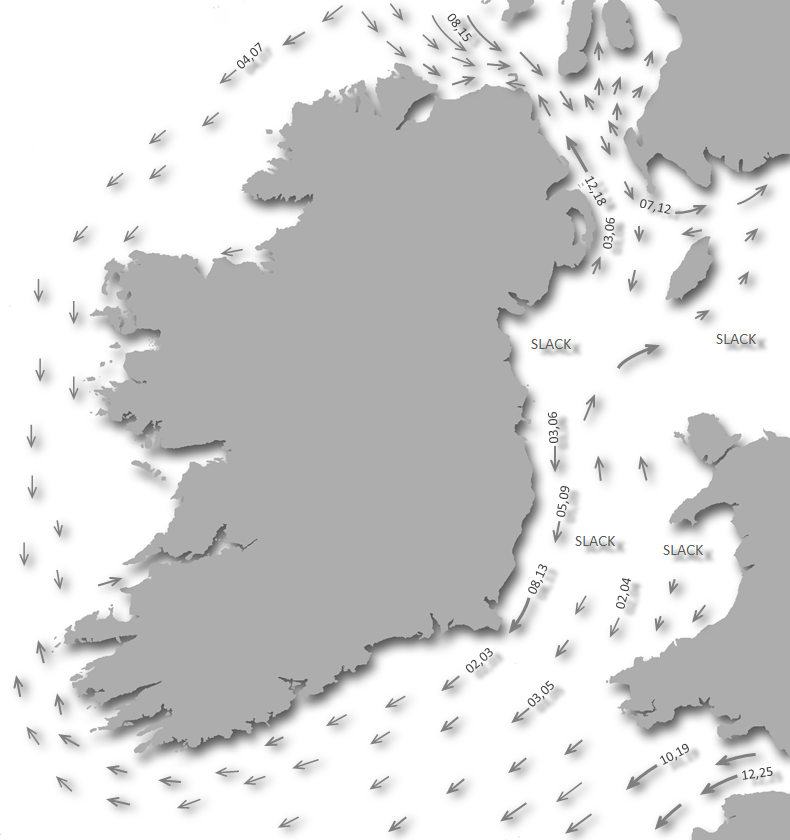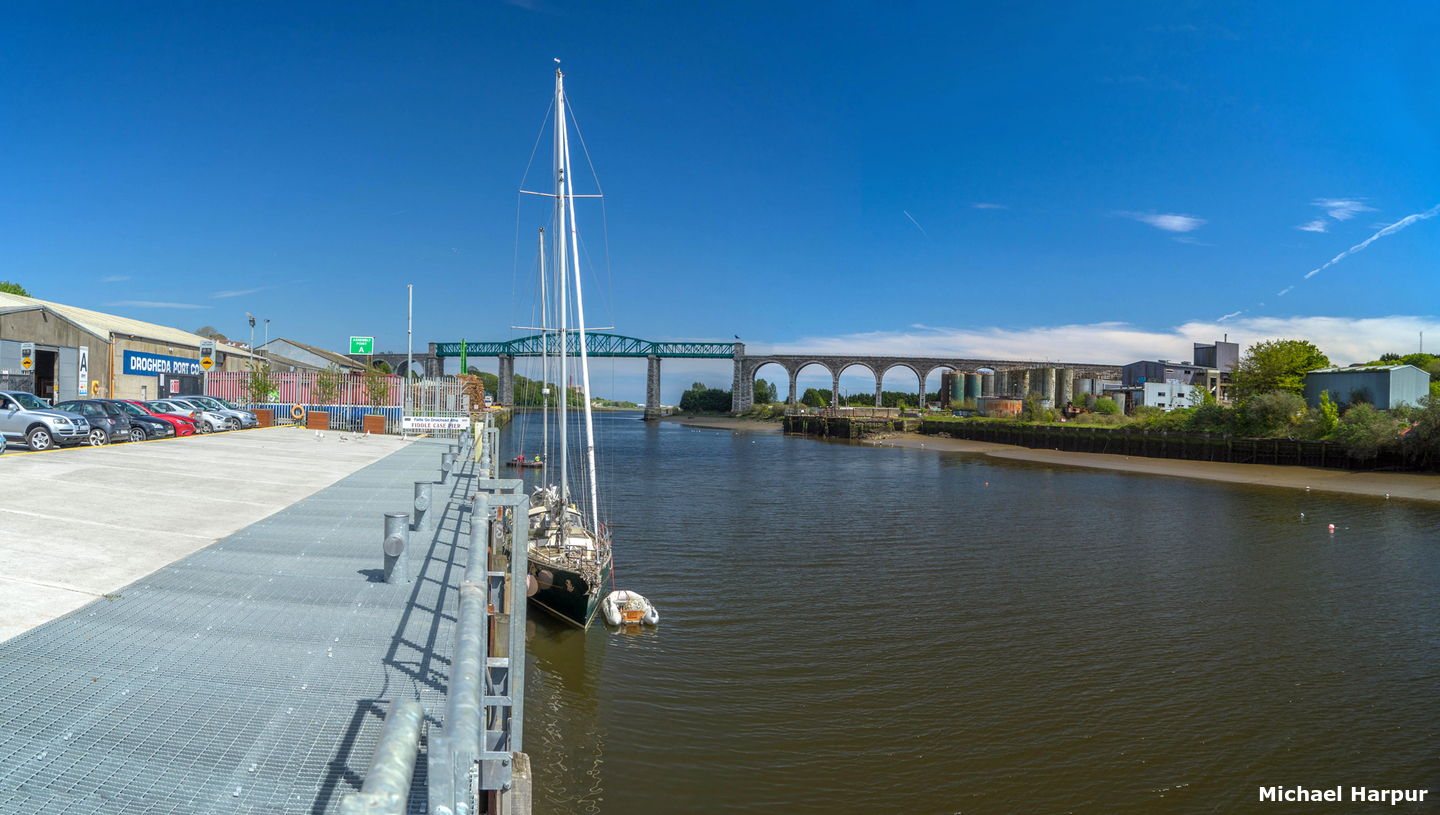
Drogheda, on the east coast of Ireland, is located on the River Boyne about four miles from its river mouth that enters the Irish Sea thirty miles north of Dublin. It is a sizeable provincial town and busy port that has designated pier for visiting leisure craft.
Once inside the river entrance, the River Boyne provides complete protection. The channel's maintained depth, numerous commercial channel marks and sectored light make access straightforward night or day, at all stages of the tide in moderate onshore and all offshore winds. With onshore winds, the Boyne entrance can be challenging and newcomers should not make an approach in anything above a force five from southeast round to east. Slightly worse is anything to the north of east, round to the north, as this causes a big confused swell at the entrance that tends to push leisure craft towards the entrance's southern beach. It is advisable not to try entering in anything over force four from these quarters. Once inside the entrance, it immediately flattens out in the highly protected channel.

Keyfacts for Drogheda & The River Boyne
Summary
A completely protected location with straightforward access.


















Nature







Considerations
Position and approaches
Haven position
 53° 42.965' N, 006° 20.465' W
53° 42.965' N, 006° 20.465' WAt the town quays situated on the north side of the river approximately 600 metres west of Boyne Viaduct.
What is the initial fix?
 53° 43.298' N, 006° 12.630' W
53° 43.298' N, 006° 12.630' W What are the key points of the approach?
 .
.- Do not attempt in strong onshore winds.
- Approach the marked entrance from due east.
- Once inside the entrance follow the well marked shipping channel.
Not what you need?
- Port Oriel (Clogher Head) - 6.5 nautical miles NE
- Balbriggan Harbour - 8.5 nautical miles SE
- Skerries Bay and Harbour - 11.4 nautical miles SE
- Loughshinny - 13.8 nautical miles SE
- Rogerstown Inlet - 14.7 nautical miles SSE
- Rush Harbour - 14.9 nautical miles SE
- Giles Quay - 16.5 nautical miles NNE
- Malahide - 17.1 nautical miles SSE
- The Boat Harbour - 17.3 nautical miles SE
- Saltpan Bay - 17.4 nautical miles SE
- Port Oriel (Clogher Head) - 6.5 miles NE
- Balbriggan Harbour - 8.5 miles SE
- Skerries Bay and Harbour - 11.4 miles SE
- Loughshinny - 13.8 miles SE
- Rogerstown Inlet - 14.7 miles SSE
- Rush Harbour - 14.9 miles SE
- Giles Quay - 16.5 miles NNE
- Malahide - 17.1 miles SSE
- The Boat Harbour - 17.3 miles SE
- Saltpan Bay - 17.4 miles SE
What's the story here?
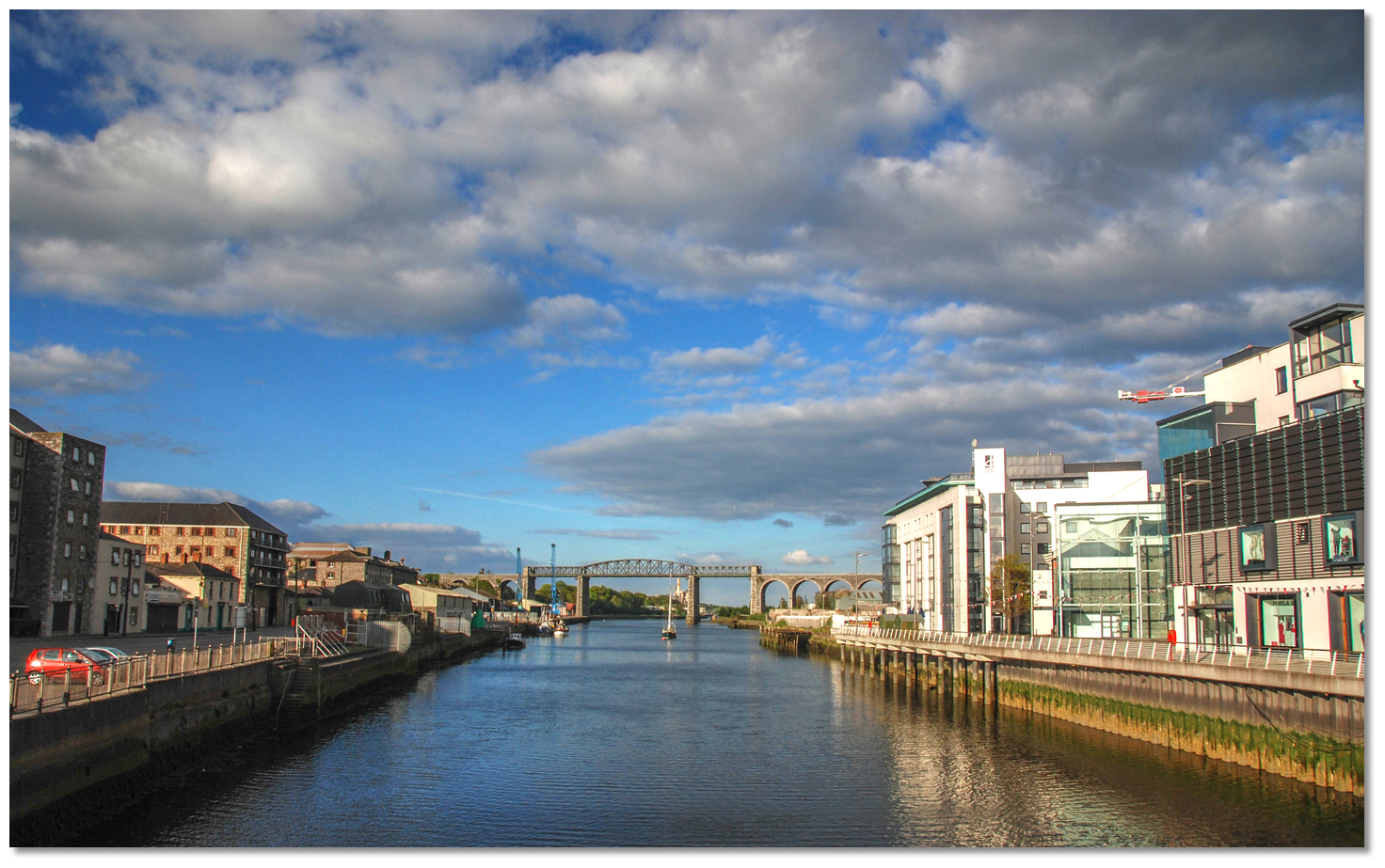 The town of Drogheda
The town of DroghedaImage: Michael Harpur
Drogheda is a historic town situated on both sides of the River Boyne about 4½ miles upriver from where it empties into the Irish Sea. It is a large provincial town that is one of the oldest towns in Ireland and is a today centre of industry and medical care. Accordingly, its port, as well as various quays along the river, the most important being Tom Roe's Terminal located about 1 mile downstream from Drogheda’s town quays, make this a centre of considerable commercial activity.
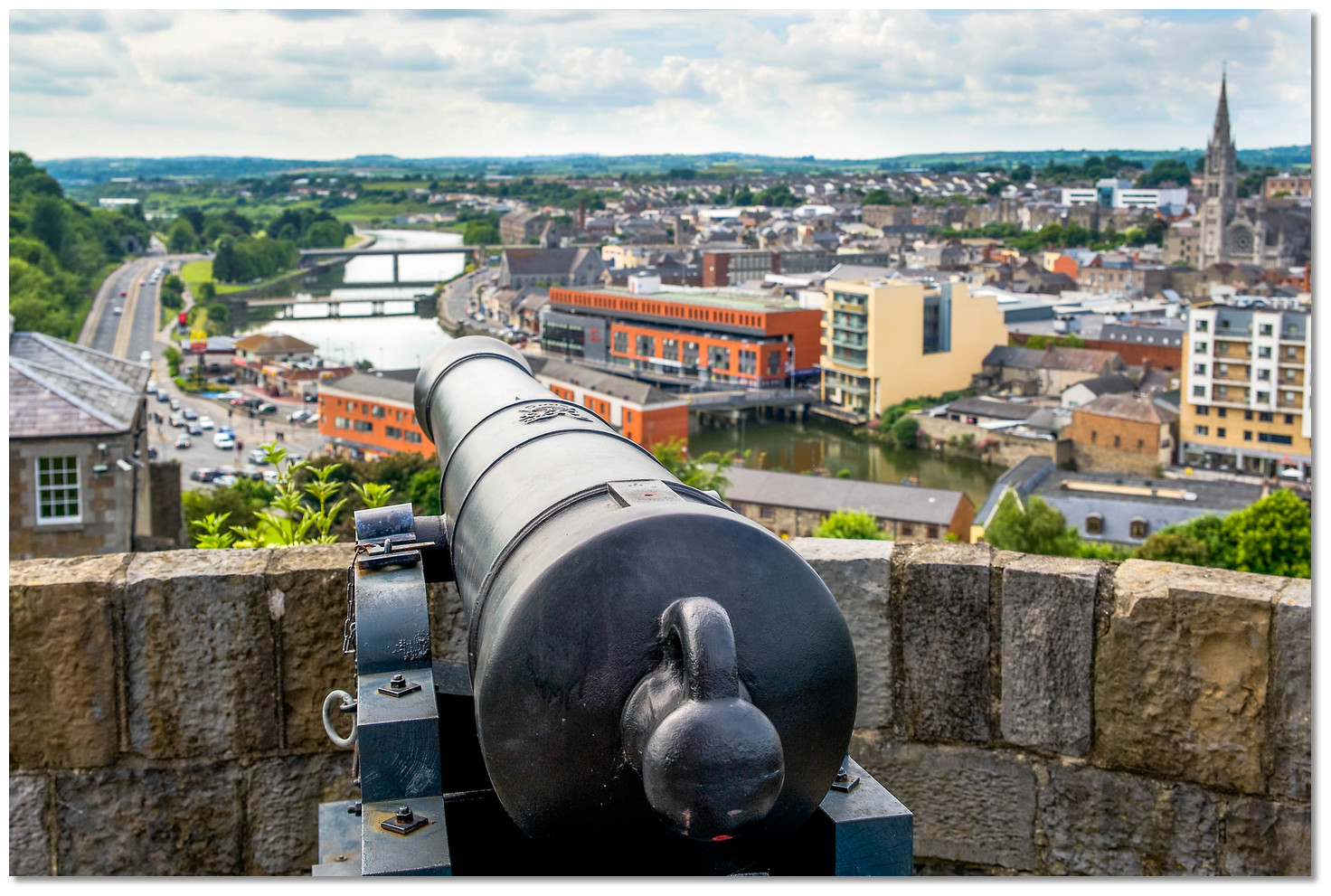 Drogheda as seen from Millmount Fort
Drogheda as seen from Millmount FortImage: Tourism Ireland
Drogheda receives visiting boats at 'Fiddle Case Pier' a new dedicated 40-meter pier for yachts and small leisure craft near the heart of the town. The pier can accommodate about 3 medium-sized vessels in depths of 1.0 metre CD. Once safely alongside, the bottom is soft mud, so deeper draft vessels can come alongside on the rise and subsequent groundings at LWS will pass unnoticed so long as there is no plan to leave before the water returns.
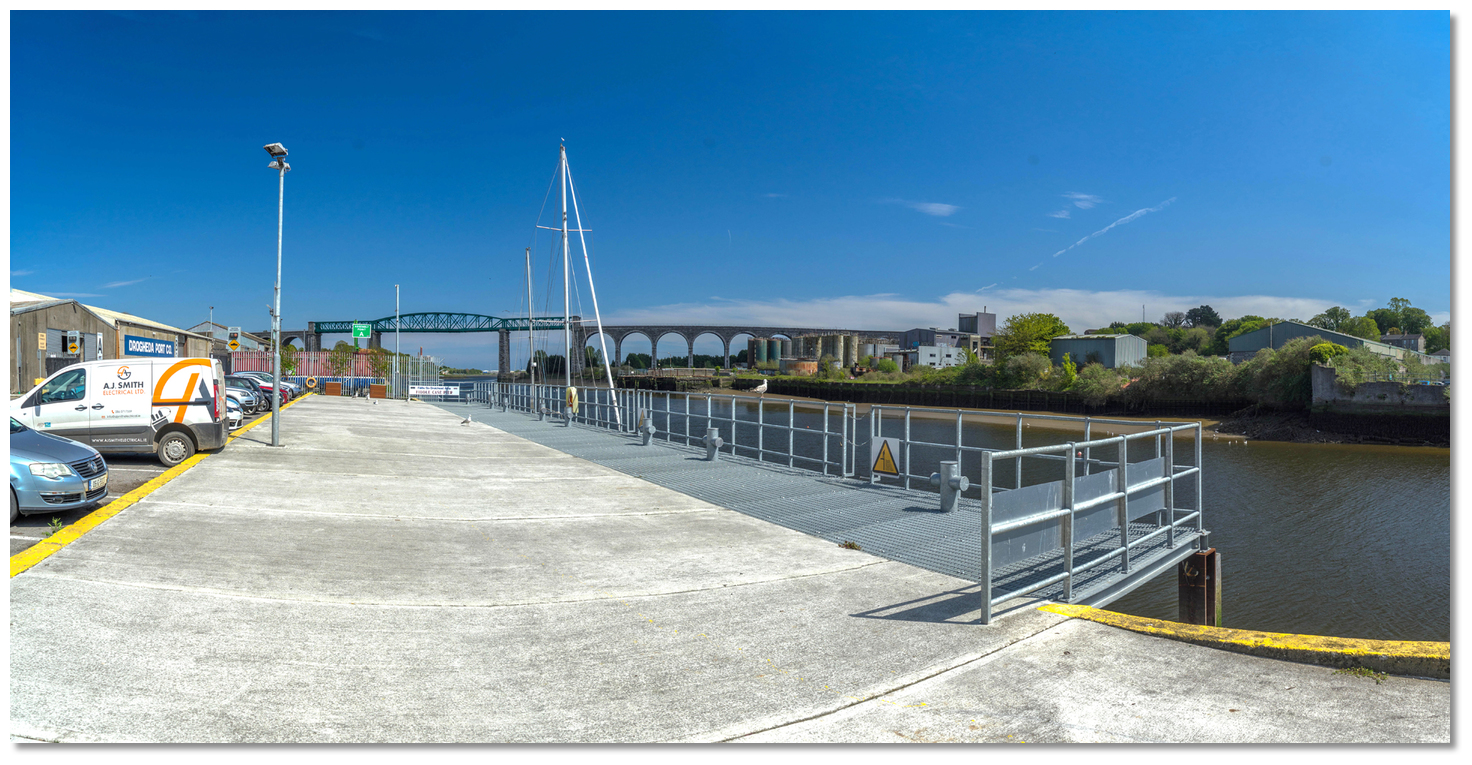 Fiddle Case Pier dedicated to leisure craft
Fiddle Case Pier dedicated to leisure craftImage: Michael Harpur
The entrance and channel to the town has a maintained depth of 2.2 metres CD to the Tom Roe's Point terminal and thereafter at 1.3 metres CD to the town of Drogheda. The best time to enter is on the latter part of the inbound stream, HW Dublin -0300 or HW Dover +0220.
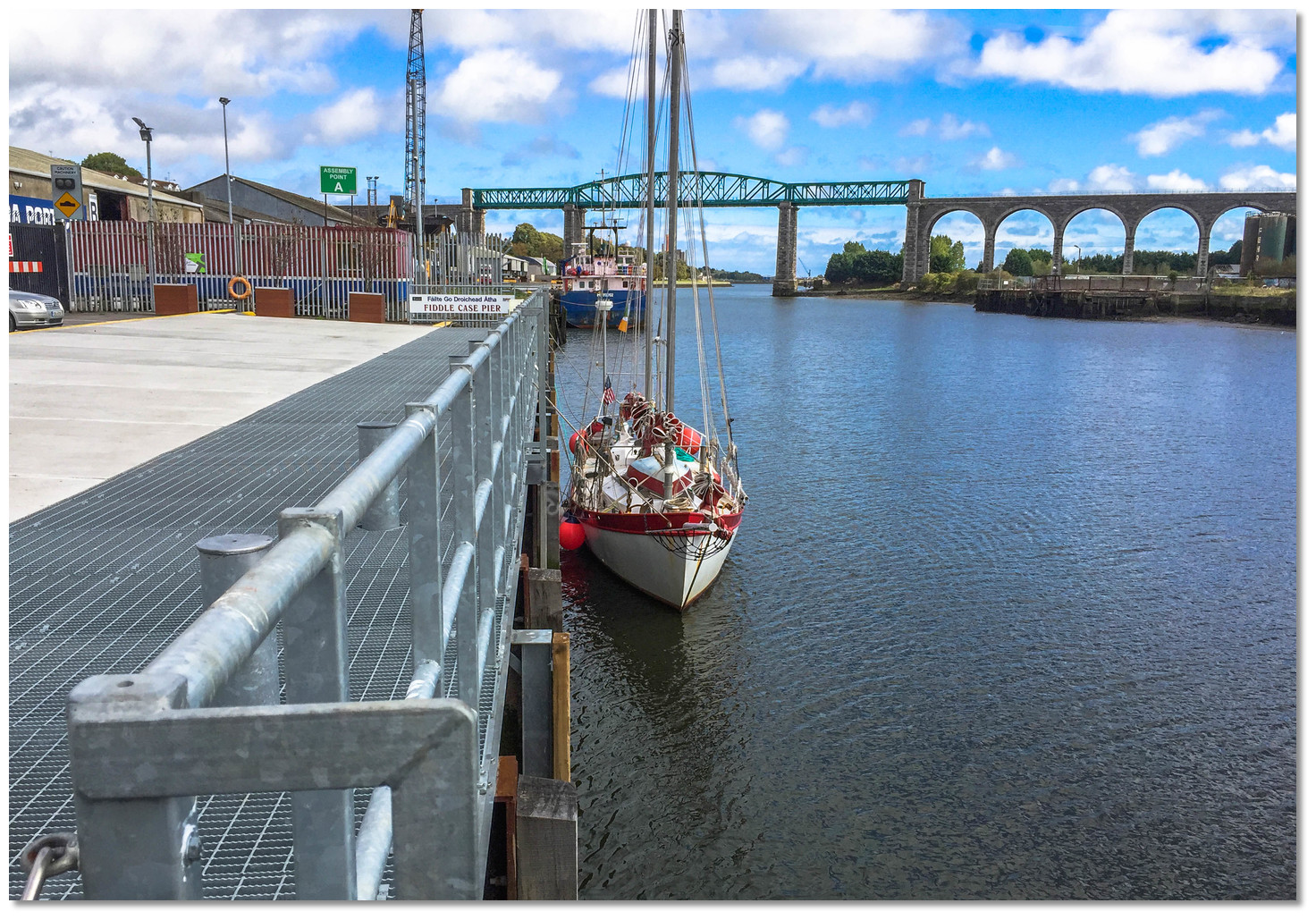 Visiting yacht alongside Fiddle Case Pier
Visiting yacht alongside Fiddle Case PierImage: Brian Lennon
Vessels are advised to make the harbour office aware of the planned entry and seek clearance before an approach is made. The harbour master is available on
 Ch. 11 [Drogheda Radio],
Ch. 11 [Drogheda Radio],  +353 (0)41 983 8385,
+353 (0)41 983 8385,  +353 86 2547827,
+353 86 2547827,  harbourmaster@droghedaport.ie,
harbourmaster@droghedaport.ie,  www.droghedaport.ie. The office is normally manned HW-3 to HW+1 or when a vessel is due. VHF Ch. 11 should be kept open when making an approach or in the river. The Harbour Master's office is a modern red-brick building situated on the north side of the town quays about 700 metres above Boyne Viaduct. Alternatively, outside of these hours contact Drogheda Port Company
www.droghedaport.ie. The office is normally manned HW-3 to HW+1 or when a vessel is due. VHF Ch. 11 should be kept open when making an approach or in the river. The Harbour Master's office is a modern red-brick building situated on the north side of the town quays about 700 metres above Boyne Viaduct. Alternatively, outside of these hours contact Drogheda Port Company  Ch. 11 [Drogheda Port Company],
Ch. 11 [Drogheda Port Company],  +353 (0)41 9838378 who are available Mon – Fri 0900 -1630 hrs.
+353 (0)41 9838378 who are available Mon – Fri 0900 -1630 hrs.From 'Tom Roe's Point' up to town quays, the depths are 1.3 metres LAT at the lowest point so a vessel carrying any draft will need to work the tides. Vessels may also freely drop anchor anywhere out of the channel and downriver at Tom Roe's Terminal. The channel is maintained to a depth of 2.2 metres LAT up to the commercial shipping terminal, and good holding will be had out of the way and just off the channel, with the assistance of a detailed chart such as Admiralty Chart 1431. The harbour office is nearby and it may be worthwhile requesting permission to lie outside the tug where 2.5 to 3 metres will be found at LWS.
There is also a small pier on Burrow Point on the port side of the river ¾ of a mile upriver from the entrance. It carries at least 3 metres of water where a vessel can come alongside the quay or raft up to a fishing boat. But it is a secured area with no external access and nothing in the immediate vicinity in any case.
How to get in?
 Seaward approaches are detailed in eastern Ireland’s coastal overview for Strangford Lough to Dublin Bay
Seaward approaches are detailed in eastern Ireland’s coastal overview for Strangford Lough to Dublin Bay  . The Boyne River approaches are free from out-lying dangers with the 5-metre 2-metre contour contours lying 1¼ and the ¾ of a mile out from the entrance. It is not however advisable to cut into the River Boyne entrance from the south. A large unnamed rock lies about 200 metres eastward of Lyons Light that is only visible on low spring tides.
. The Boyne River approaches are free from out-lying dangers with the 5-metre 2-metre contour contours lying 1¼ and the ¾ of a mile out from the entrance. It is not however advisable to cut into the River Boyne entrance from the south. A large unnamed rock lies about 200 metres eastward of Lyons Light that is only visible on low spring tides.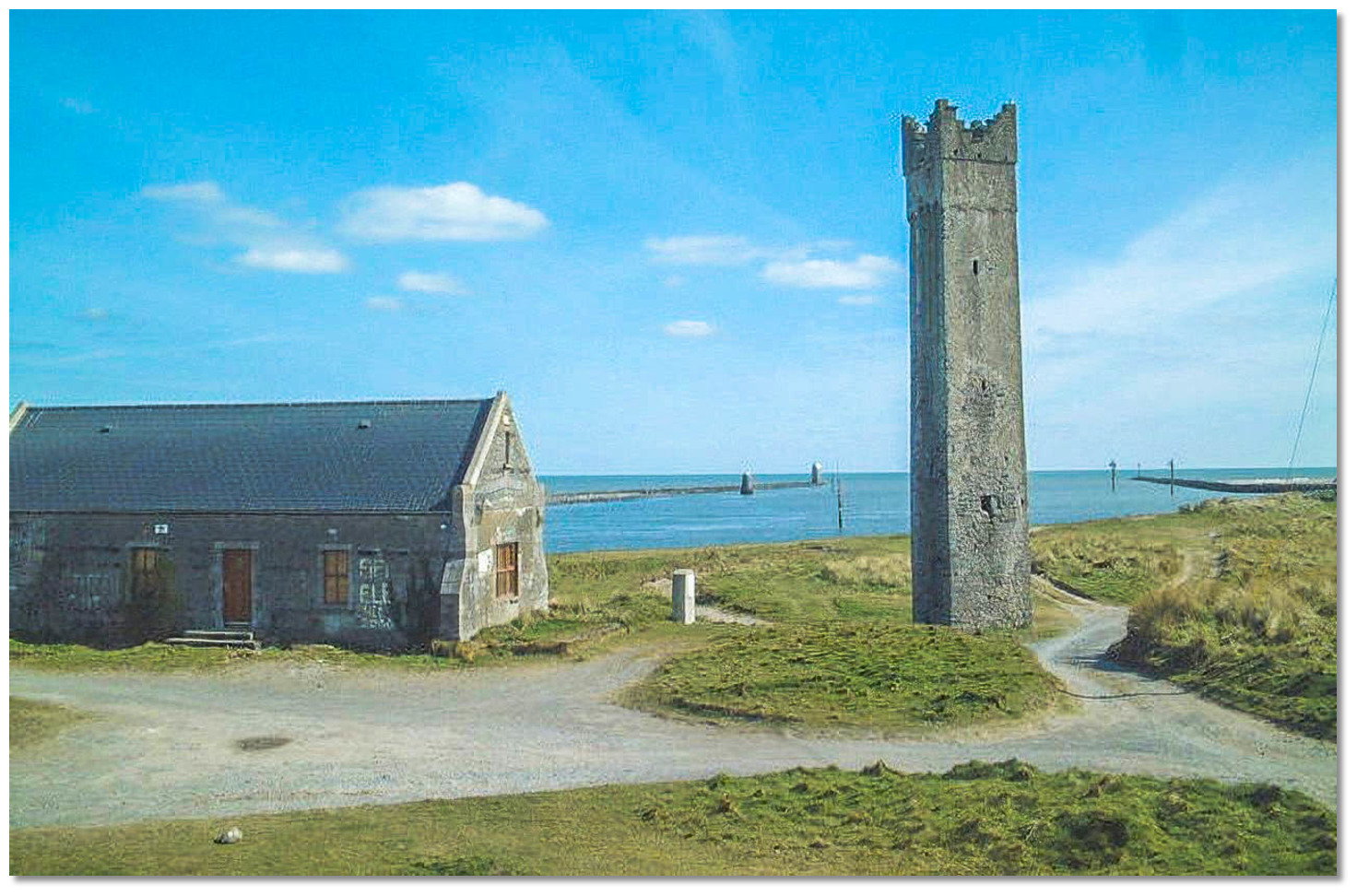 Maiden Tower, Mornington and the entrance to the River Boyne
Maiden Tower, Mornington and the entrance to the River BoyneImage: Kieran Campbell via CC BY-SA 2.0
The river entrance is located between North and South Bull training walls that are 50 metres apart and protrude seaward from drying sandbanks backed by sandhills. On the seaward end of the North Bull wall, there is a 20-metre-high black stone Aleria beacon QG 18m 3M. The entering channel, confined between sea walls, crosses the sandy foreshore in a west-by-northwest direction towards the Maiden Tower. This is a tall unlit castellated stone tower that stands on the southwest side of the river ½ a mile within the entrance. It has a small obelisk within known as the Lady's Finger and both together served as a watch station and, most likely, approach alignment marks during Elizabethan times. The entrance then takes the direction of the shore, north by west to Crook Point, 1 mile distant from the bar, where the river is fairly entered.
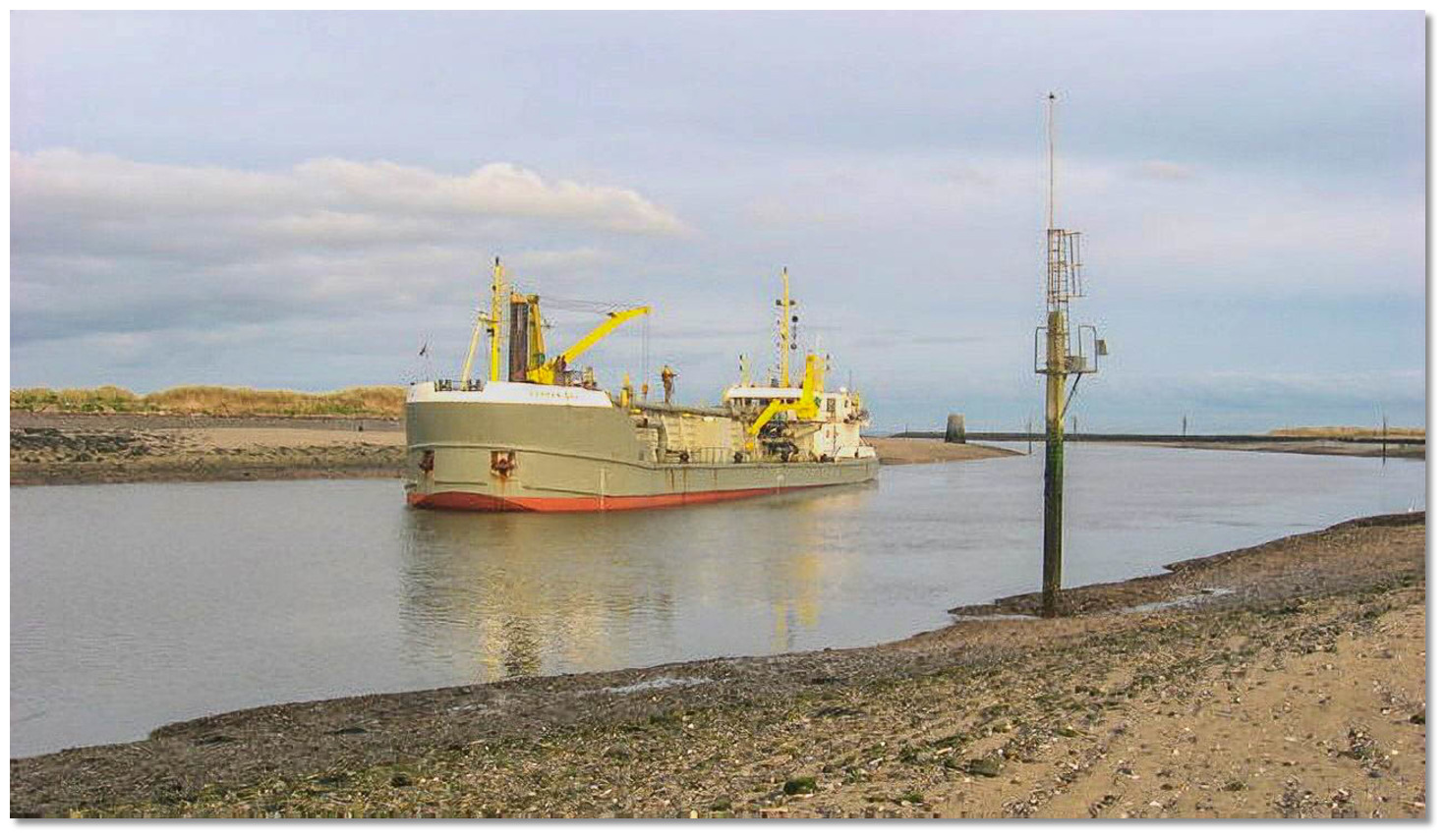 Ship just inside the entrance at low water
Ship just inside the entrance at low waterImage: Kieran Campbell via CC BY-SA 2.0
Inside the entrance, it is all sand and mudflats that dry at low water, in which there no rocks and nothing hard to hit. Drogheda is, however, a busy commercial port with 1,400 annual vessel movements. There is plenty of room to meet passing vessels but leisure craft should take care not to impede commercial traffic in the narrow entrance or channel as these are highly restricted waterways for large ships.
 Vessels approaching from the initial fix may come in bearing 270°T, or due west, into the river’s entrance channel. The coast in the backdrop is of moderate elevation backed by low hills about 4 miles inland that so the entrance will be highly visible in normal conditions.
Vessels approaching from the initial fix may come in bearing 270°T, or due west, into the river’s entrance channel. The coast in the backdrop is of moderate elevation backed by low hills about 4 miles inland that so the entrance will be highly visible in normal conditions. At night both breakwater heads are lit as well as is the channel up to the viaduct.
Drogheda North Bull Aleria Light – QG 18m 3M position: 53° 43.350' N, 006° 14.332' W
Image: Kieran Campbell via CC BY-SA 2.0
On the seaward end of the South Bull is the corresponding Lyons red metal tower Fl (3) R5s beacon.
Drogheda South Bull Lyons Light - Fl (3) R5s position: 53° 43.225' N, 006° 14.258' W
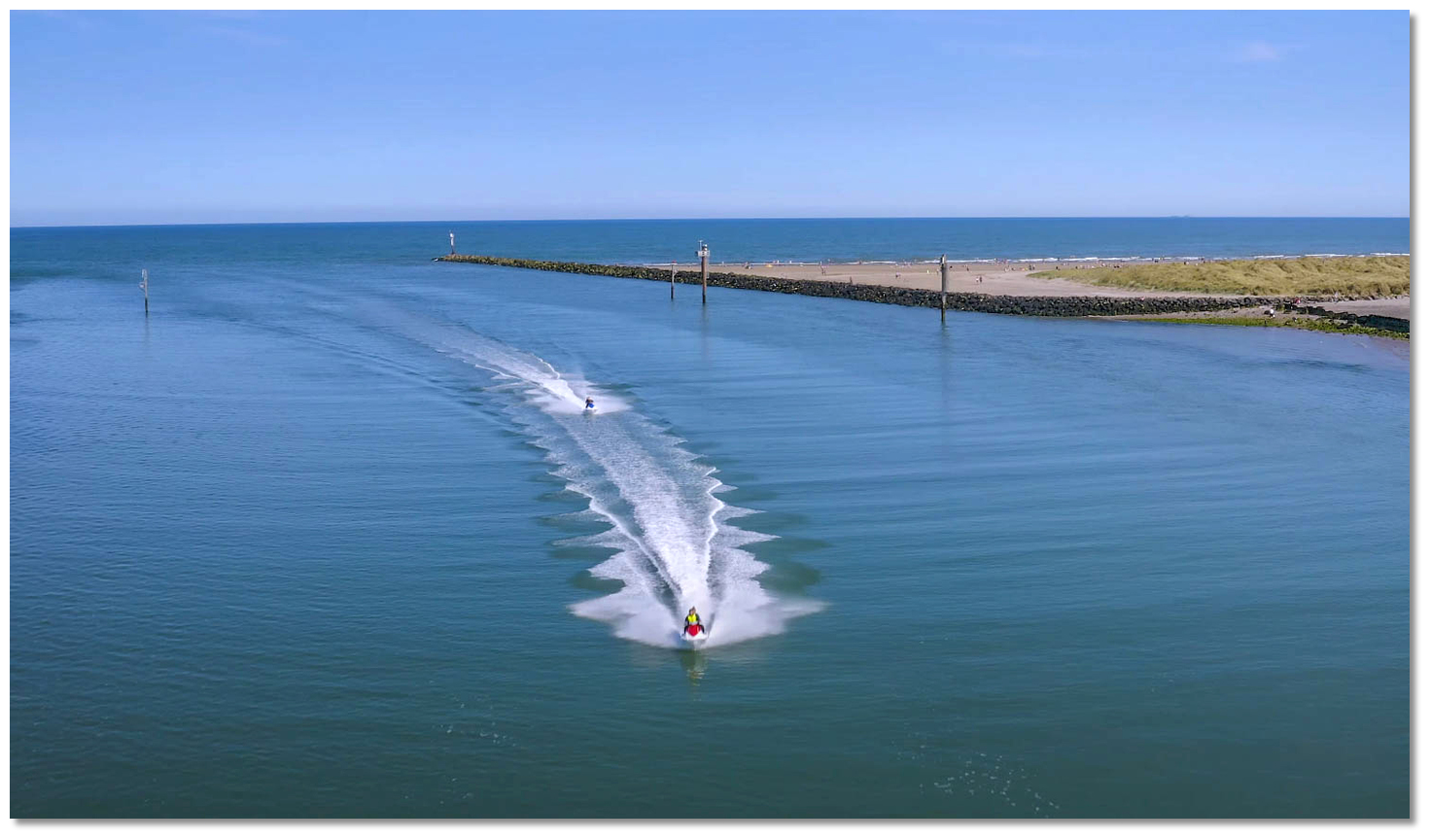 The River Boyne Port Approach Direction Light on the south side of the entrance channel
The River Boyne Port Approach Direction Light on the south side of the entrance channelImage: Aidan Curran

The River Boyne Port Approach Direction Light is on a post situated on the south side of the channel.
River Boyne Port Approach Direction Light – WRG.10m19/15M position: 53° 43.298' N 006° 14.639' W
It provides a narrow white sector light with a total beam width of 1° between 269.5°- 270.5°T. The entrance red and green sectors are likewise narrow and only 7°.
Once all is identified, track in along the leading-light alignment marks that takes a vessel in over the sandbar.
The dredged channel commences 700 metres east of the seaward ends of the breakwaters and has a maintained minimum depth of 2.2 metres CD.
Continue on track into the channel between the breakwater heads of Aleria and Lyons and then steer towards the Maiden Tower. From there on in, the River Boyne channel is marked with frequent pairs of lateral light-beacons. These stand outside the dredged channel on each side of the river with conspicuous stone beacons, standing near the margin of low water. All that is required is to steer a centre line between the paired navigational marks up to Drogheda town quays.
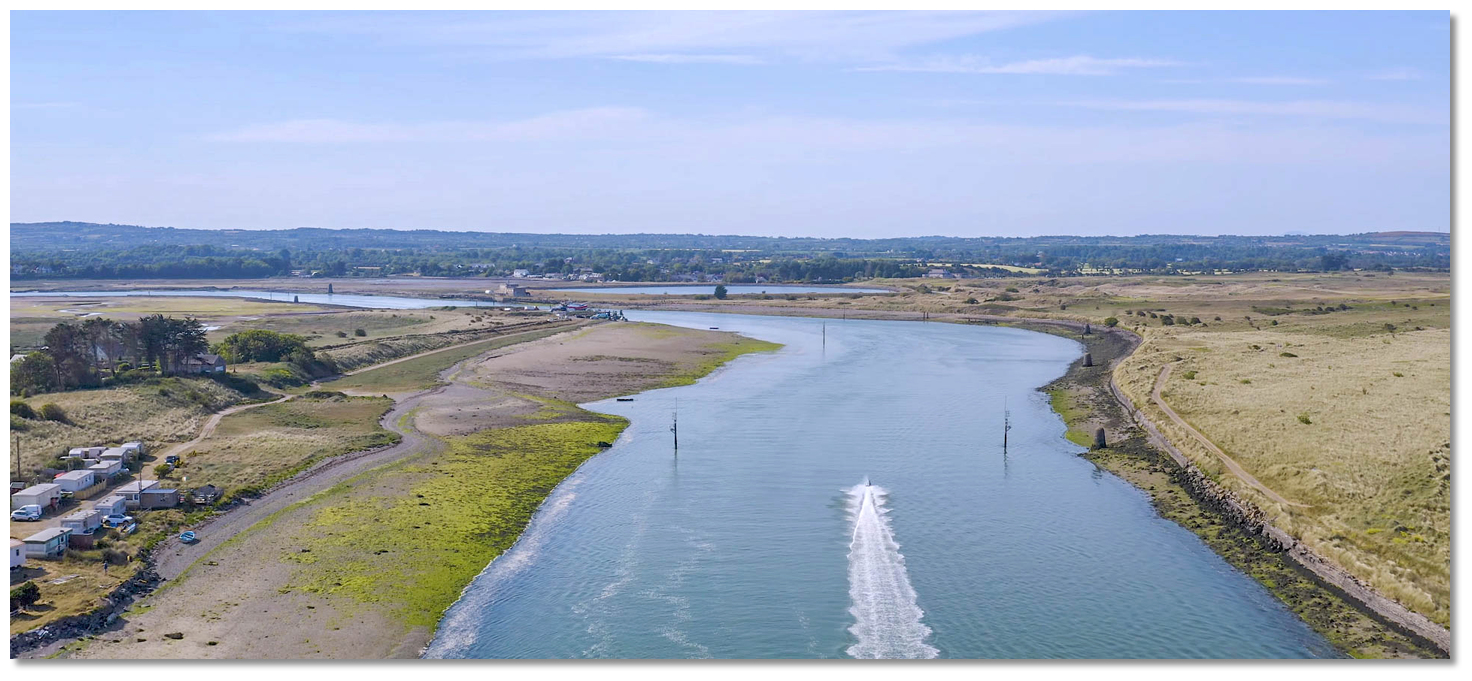 Burrow Point and Fishmeal Quay at the head of the first leg with the entrance
Burrow Point and Fishmeal Quay at the head of the first leg with the entranceImage: Aidan Curran
The town quay is situated on the north side of the river and to the west of the Boyne Viaduct that carries a railway line over the river. Hence those intending upon berthing at the Fiddle Case Pier must pass under the Boyne Viaduct. From the bridge under-structure to top of quay concrete there is an airdraft of 26 metres HAT. Additional clearance for the height of tide below the quay can be accessed by an airdraft gauge positioned at the viaduct.
 The first opportunity to quickly come alongside and tie up is at the Fishmeal Jetty at Burrow point opposite Crooke Point. This is named after a fish meal processing factory that was located there in past times.
The first opportunity to quickly come alongside and tie up is at the Fishmeal Jetty at Burrow point opposite Crooke Point. This is named after a fish meal processing factory that was located there in past times. Fishmeal Quay - East corner 2 F R (vert) position: 53° 43.837'N, 006° 15.619'W
This is a small pier on the port side of the river ¾ of a mile upriver from the entrance. At least 3 metres of water will be found here either alongside the quay or rafted up to a fishing boat. Apart from the pier, there is nothing in the immediate vicinity ashore here. Additionally, as it is occasionally used by the Irish army, the quay is a secured area that requires an authorised fisherman to open the gates.
Likewise, vessels may freely drop anchor anywhere out of the channel and downriver at 'Tom Roe's Terminal'. The channel is maintained to a depth of 2.2 metres LAT up to the commercial shipping terminal, and good holding will be had out of the way just off the channel, with the assistance of a detailed chart such as Admiralty Chart 1431. The harbour office is nearby and it may be worthwhile requesting permission to lie outside the tug where 2.5 to 3 metres will be found at LWS.

_past_premier_periclase_has_a_least_depth_of_1.3_metres.jpg) The run from Tom Roe's Terminal (right backdrop) past Premier Periclase
The run from Tom Roe's Terminal (right backdrop) past Premier Periclase has a least depth of 1.3 metres
Image: Michael Harpur
From 'Tom Roe's Point' up to town quays, the depths are 1.3 metres LAT at the lowest point so a vessel carrying any draft will need to work the tides. Two hours flood from there should be more than sufficient for most vessels to proceed upriver for the last mile to the town quay.
The dedicated yacht mooring the 'Fiddle Case Pier' will be found on the north side of the river, 400 metres upstream of the Boyne Viaduct and just past the towns commercial shipping quays. The 40 metres pier comprises an open pile metal structure with vertical timber fenders at 3-metre centres and ample sturdy access ladders. Fender boards, if available would be well deployed. Berth, on the flood tide, port side to, there is ample swing room to turn around.
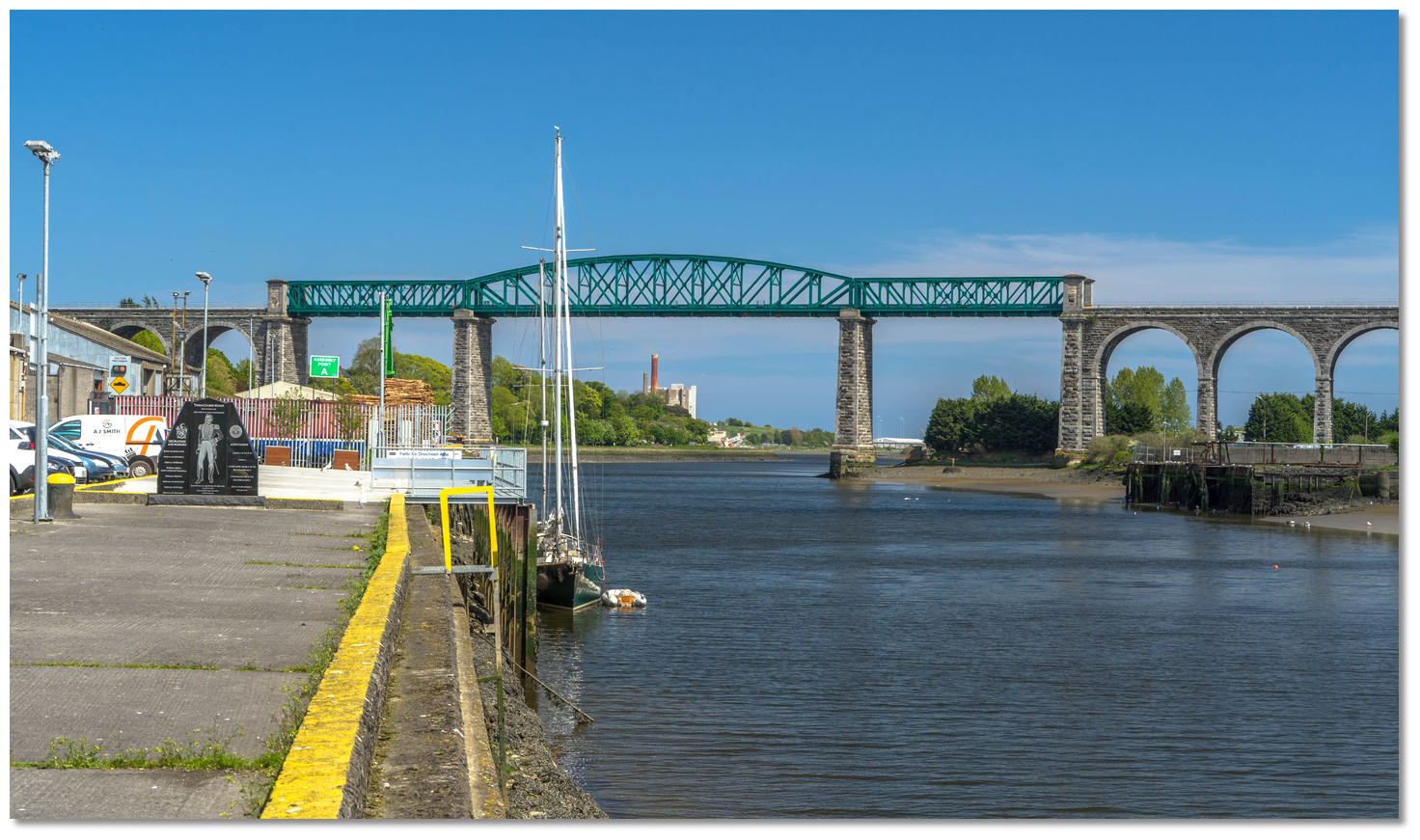 Fiddle Case Pier situated 400 metres upstream of the viaduct
Fiddle Case Pier situated 400 metres upstream of the viaductImage: Michael Harpur
There are further town quays upriver but these are not suitable for berthing as there is a wreck in this area. Above this, there is a pedestrian bridge and then a road bridge that marks the effective limit for sailing craft.
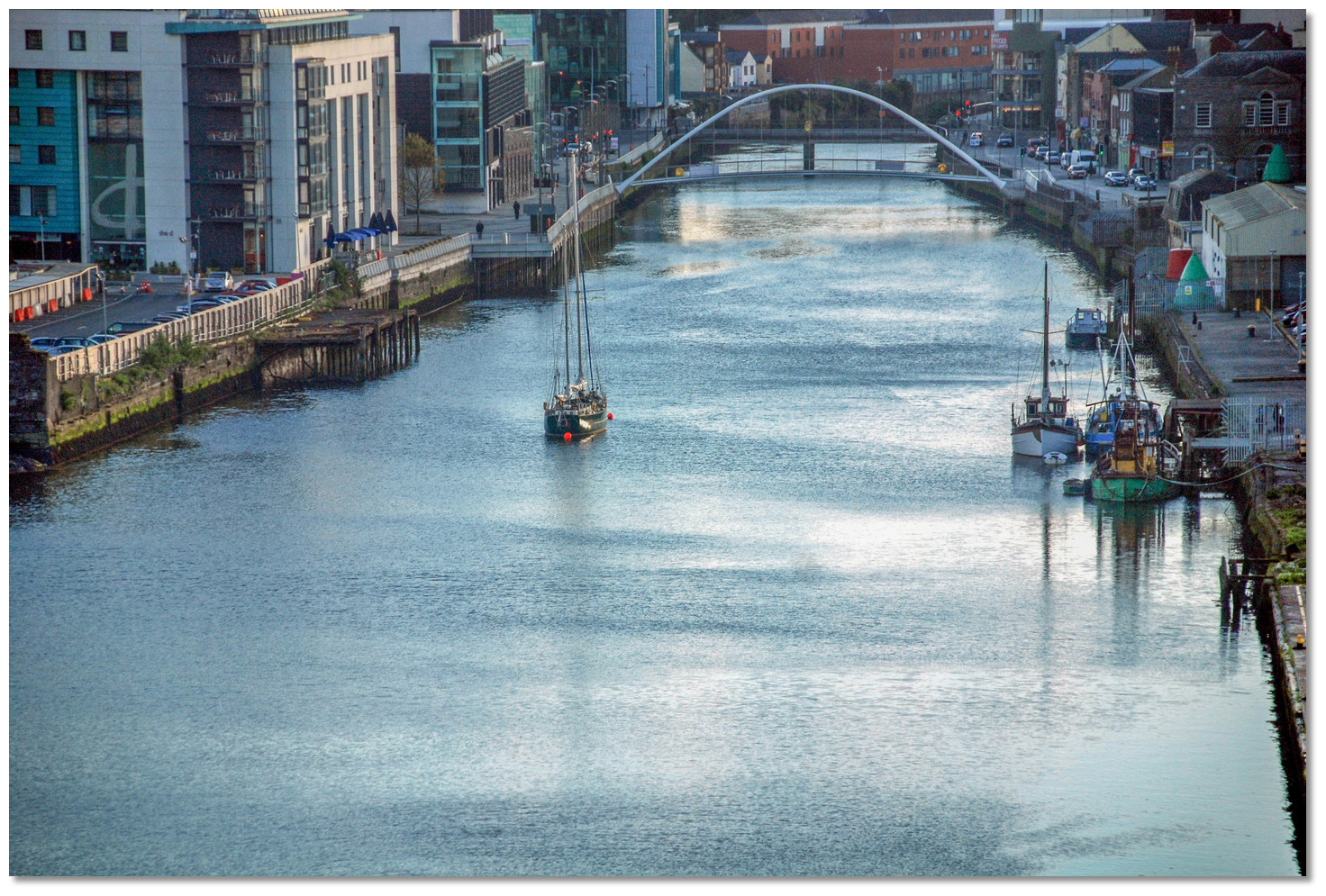 Pedestrian Bridge upriver of the quays
Pedestrian Bridge upriver of the quaysImage: Michael Harpur
Why visit here?
Drogheda, in Irish 'Droichead Átha' meaning 'Ford bridge', is located in an area that is steeped in human history. The area abounds in archaeological monuments that date from the Neolithic period onwards. Most notable amongst them is the large Passage Tombs, or burial mound, of Newgrange that was a constructed around 3200 BC.The earliest notices of the town of Drogheda go back to Roman times when it was a busy trading centre called 'Inver Colpa' or the 'Port of Colpa'. The Viking Danes built on this and established a trading centre and coastal stronghold here in 911 AD. The earliest structure in the town is the Norman motte-and-bailey castle, now the footing for the Martello styled Millmount Fort, that overlooks the town from a bluff on the south bank of the Boyne. This is thought to have been erected by the Norman Lord of Meath, Hugh de Lacy sometime before 1186.
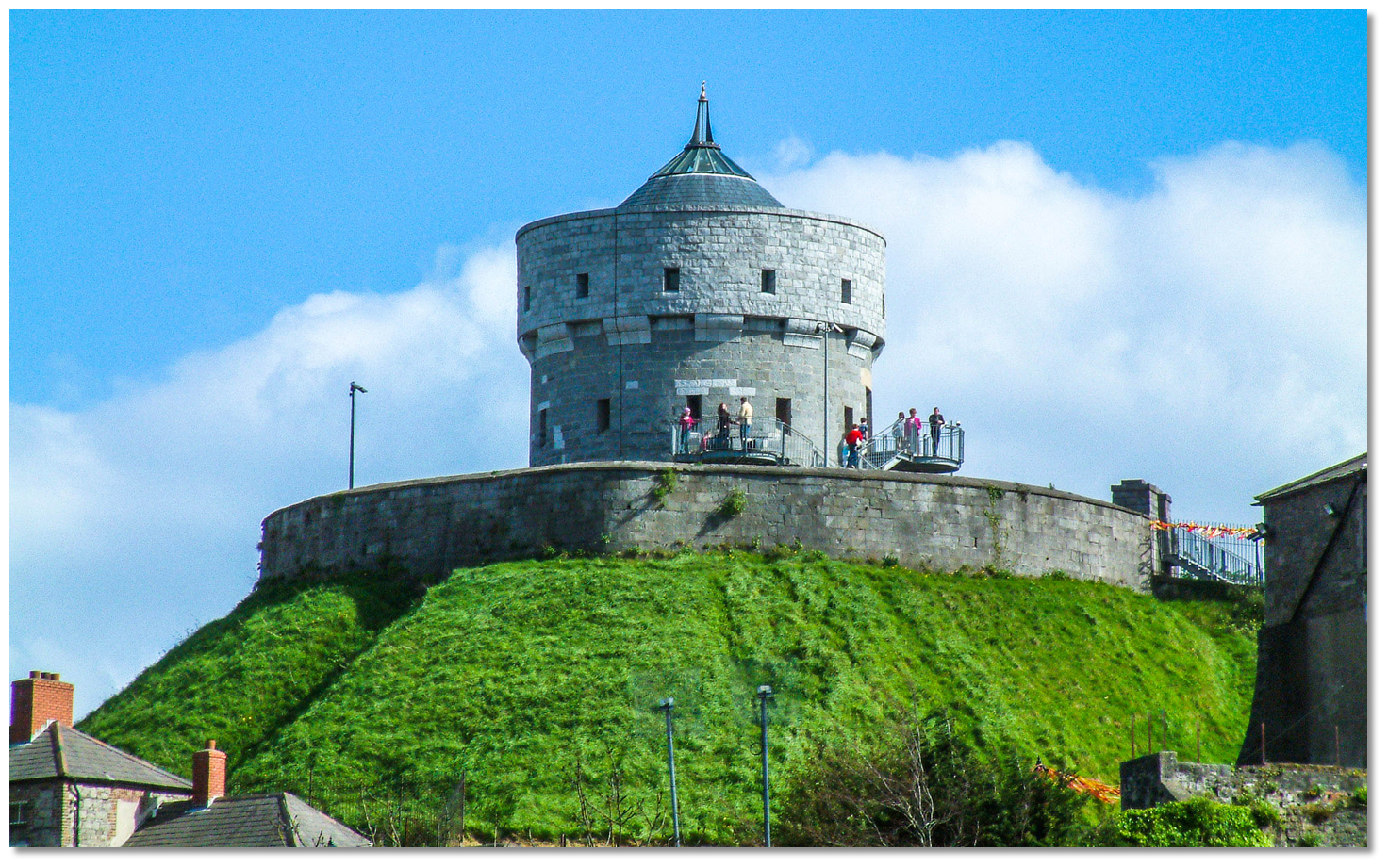 Millmount Monument
Millmount MonumentImage: Irish Typepad via cc by sa 2.0
Its most significant legacy is St Laurence's Gate. More properly described as a 'barbicans'. It stood in front of, and so provided extra protection for, a now-destroyed gateway in the Town Wall. A drawbridge Would have spanned the deep pit or ditch in the space between the barbican and the gate. The barbican was built in the 13th century, probably around 1250, when the original earthen rampart around Drogheda was replaced by a strong stone wall.
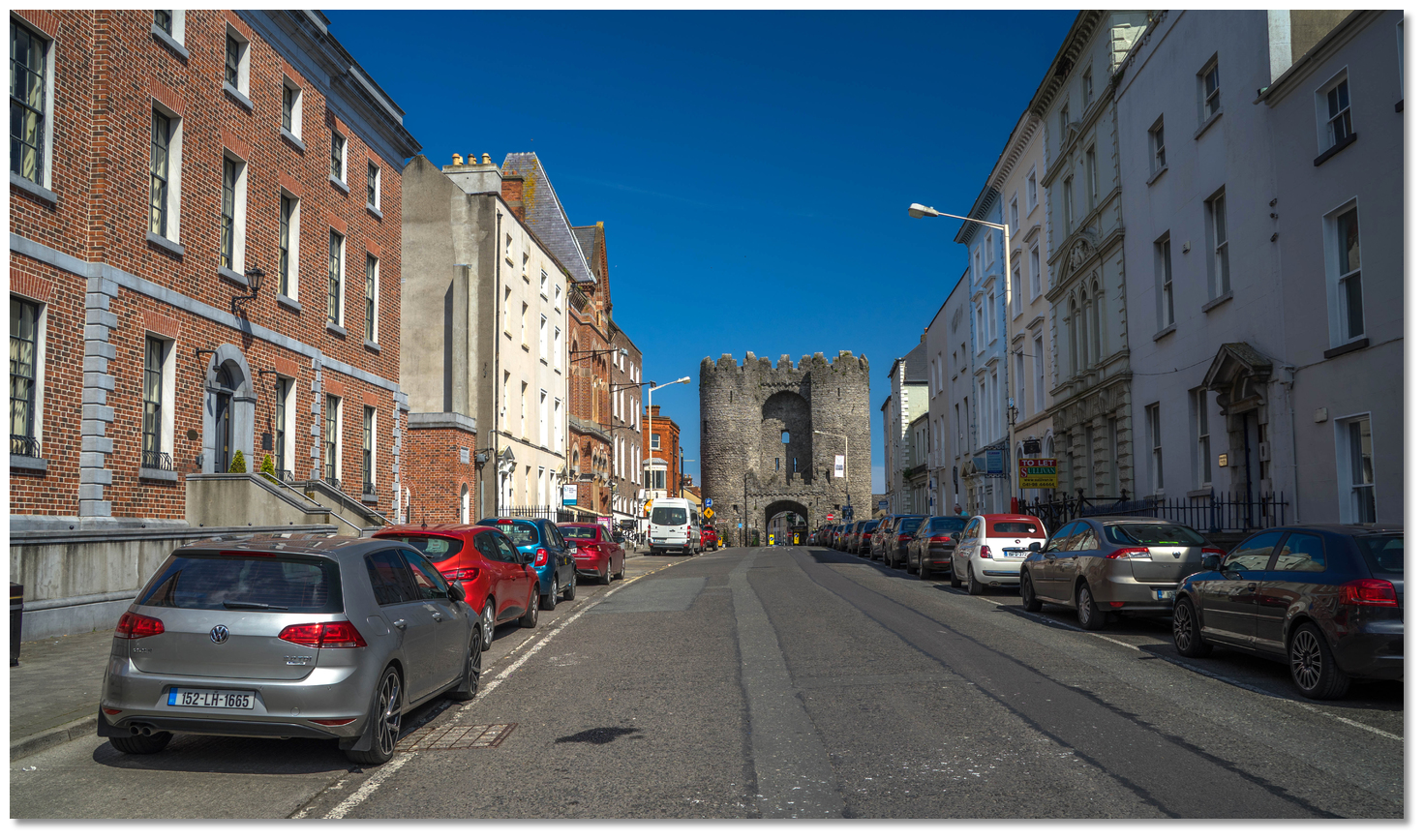 St Laurence's Gate
St Laurence's GateImage: Michael Harpur
Drogheda took off under the Normans who found it as two separately administered towns in two different territories. Drogheda versus Midiam, County Meath as it was then known, i.e. the Lordship and Liberty of Meath, which was granted its charter by Walter de Lacy in 1194. Then Drogheda versus Uriel, as County Louth was then known, on the northern bank, that received its town charter in 1229. The division came on account of the 12th-century boundary between two Irish kingdoms, colonised by different Norman interests, just as the River Boyne continues to divide the town between the dioceses of Armagh and Meath. Although they immediately bordered one another, the two towns had separate corporations, taxes, tariffs and landing charges. Being an important trading town disputes soon arose when trading vessels landing their cargoes in the southern town, to avoid the duty levied in the northern town. At length, and after much blood had been shed in many disputes, Philip Bennett, a town monk, succeeded on the festival of Corpus Christi, 1412, in persuading the authorities of the two corporations to send to Henry IV for a new charter sanctioning their combination. In November of that year that a new Charter was granted, unifying the two towns as a County Corporate, styled as 'the County of the town of Droghede'.
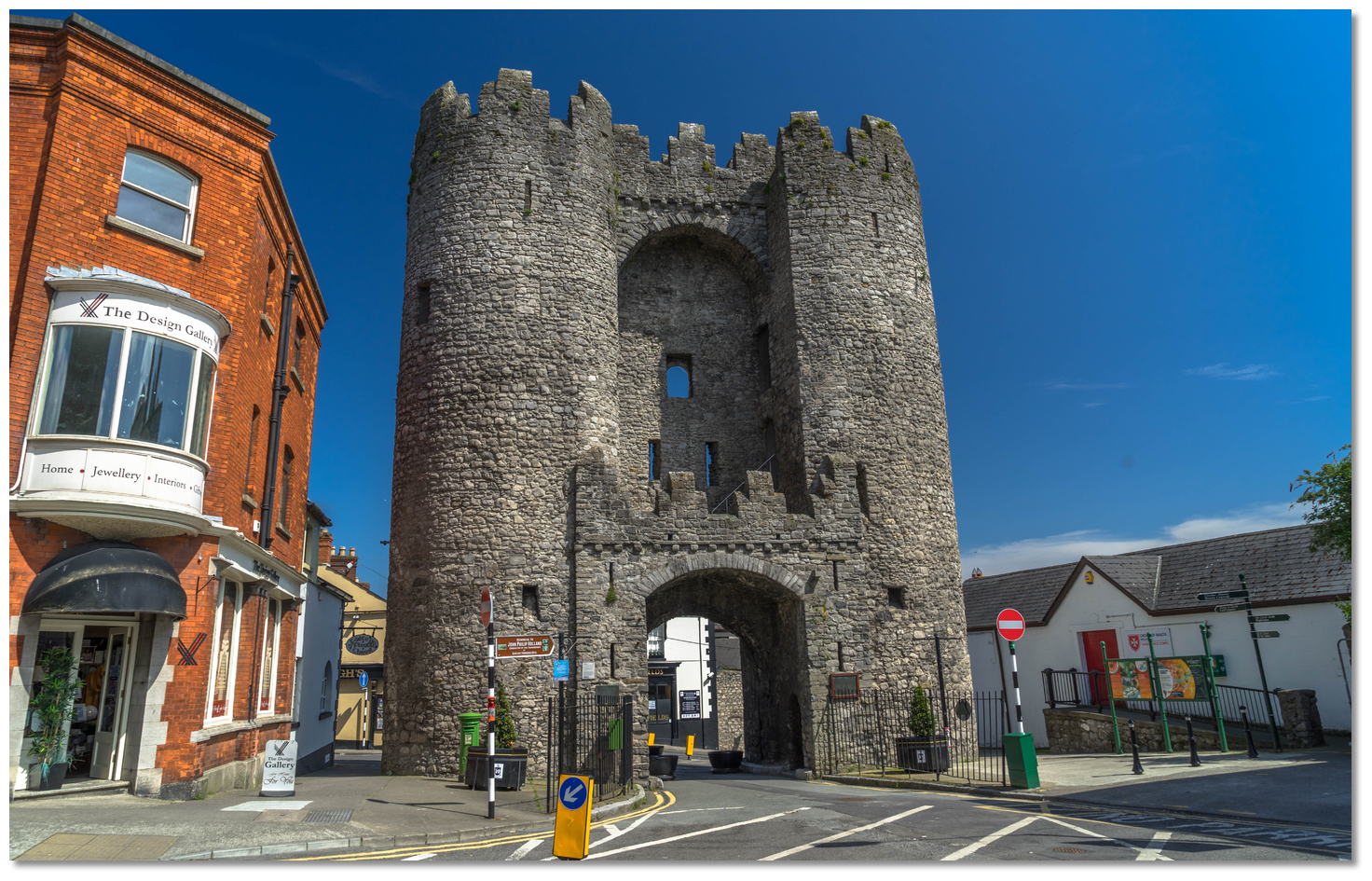 St Laurence's Gate more properly described as a barbican
St Laurence's Gate more properly described as a barbicanImage: Michael Harpur
Since Anglo/Norman times Drogheda was always considered by the English as an important place and as it was a walled town, that was less liable to attack from the natives, was largely settled by them. In the reign of Edward III, it was classed along with Dublin, Waterford and Kilkenny as one of the four staple towns of Ireland. In 1394, it was an important site when Richard II landed with his extensive army, the first King to come to Ireland since King John in 1210. Richard restored the power of his lordship over the whole of Ireland and gained the submission of 75 Irish chiefs at meetings in Drogheda as well as Carlow in 1395. It was here that the largest part submitted including the Irish princes of Leinster and Ulster. The town went on to be an important walled town in the English Pale, during the medieval period when it had the right to coin money and it frequently hosted meetings of the Irish Parliament. In a December 1494 an assembly of the parliament in Drogheda was held by the then recently-arrived Lord Deputy of Ireland, Sir Edward Poynings, as appointed by King Henry VII of England, that would seal the faith of the nation for 300 years.
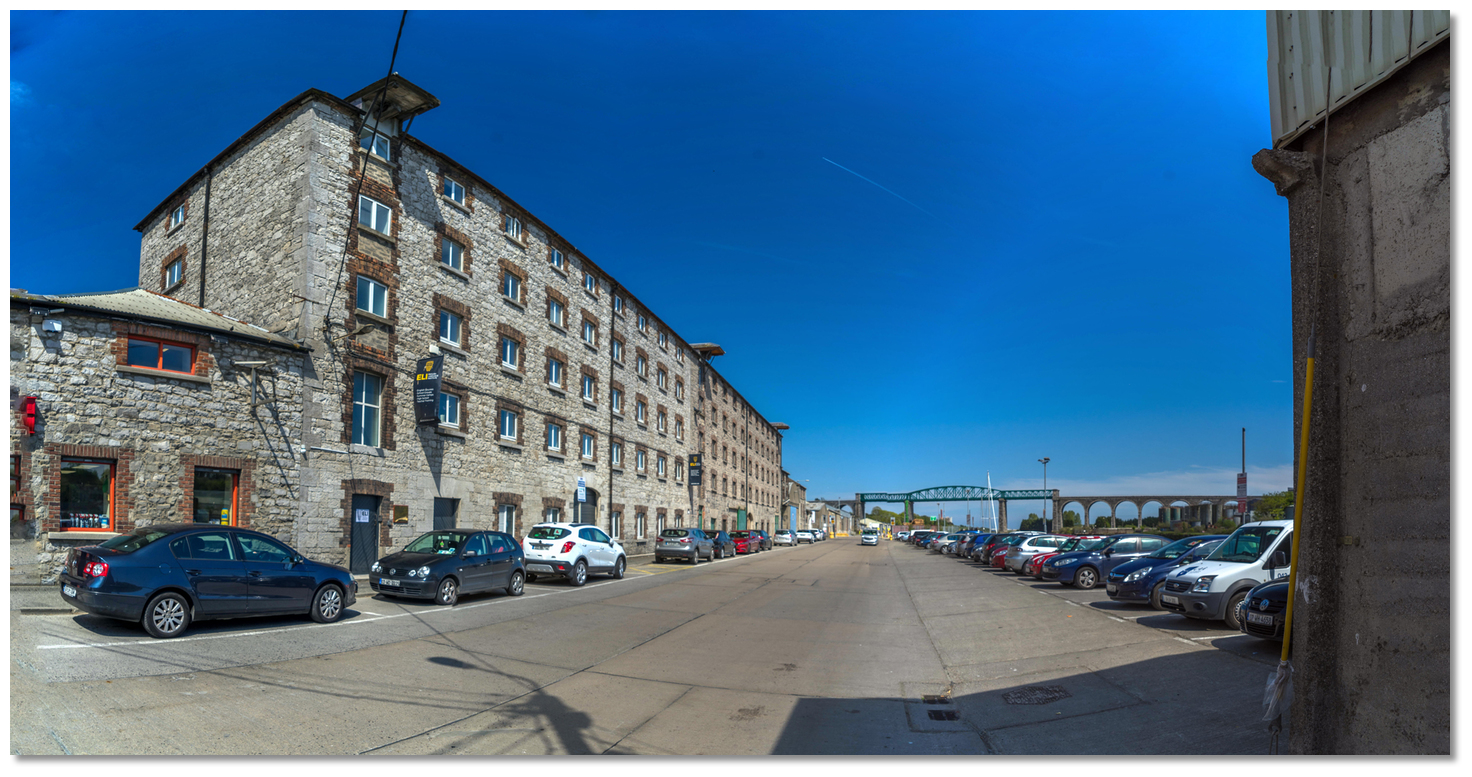 Warehouses along Drogheda's wharfs today
Warehouses along Drogheda's wharfs today Image: Michael Harpur
English authority in Ireland had at this time all but disappeared. Coming in the aftermath of the divisive Wars of the Roses, Poynings intended to curb the independence of Ireland’s Anglo-Norman chief governors and, once again, make Ireland obedient to the English monarchy. So, he enacted the 'Poynings' Law' or 'Poynings' Act' of 1495 that was formally known as the 'Statute of Drogheda'. This declared that the Parliament of Ireland was thereafter to be placed under the authority of the Parliament of England which limited its power and gave the English Parliament, and monarch, the power of veto over its legislation.
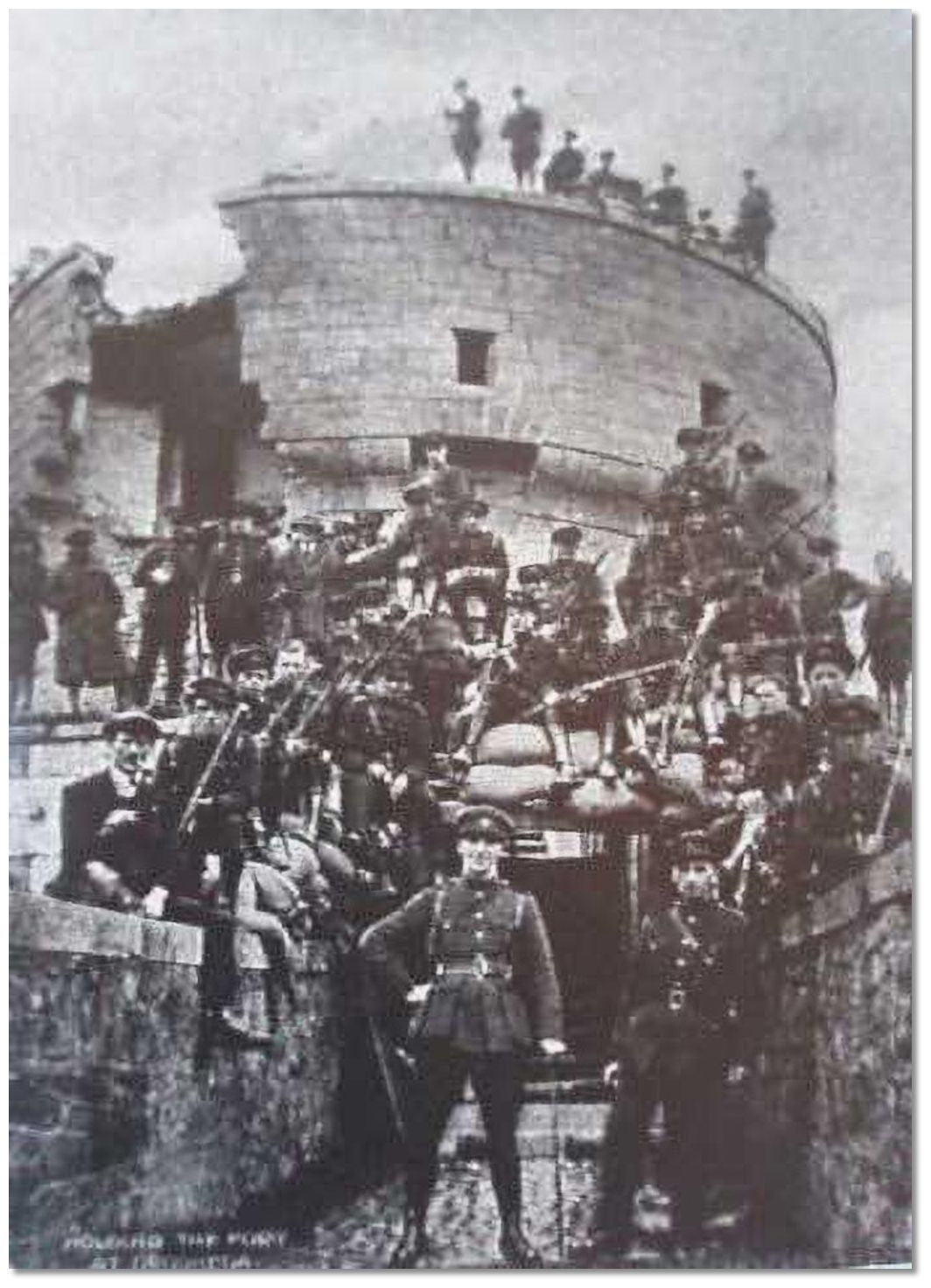 The aftermath of the shelling of Millmount in 1922
The aftermath of the shelling of Millmount in 1922Image: Public Domain
It was noted that the Irish parliament "most willingly and joyously" consented to a Bill conferring on him the title 'King of Ireland'. But this was far from the case and the Irish Parliament resented its restrictive effect. Poynings' Law was a major rallying point for groups seeking self-government for Ireland, particularly the Confederate Catholics in the 1640s that would besiege Drogheda. This, the first Siege of Drogheda, took place from November 1641 to February 1642 during the Irish Rebellion of 1641. A Catholic force under Féilim Ó Néill laid siege to the town but failed to wrest the garrison from the Royalists. The Irish rebels made three attempts to break into and capture the town. All attempts failed and the town was ultimately relieved by English reinforcements from Dublin, under Colonel Moore, who was later created the Earl of Drogheda. A second, more famous siege of Drogheda took place less than a decade later during the war in 1649, when Oliver Cromwell's New Model Army took the town and massacred its Royalist and Irish Confederate garrison.
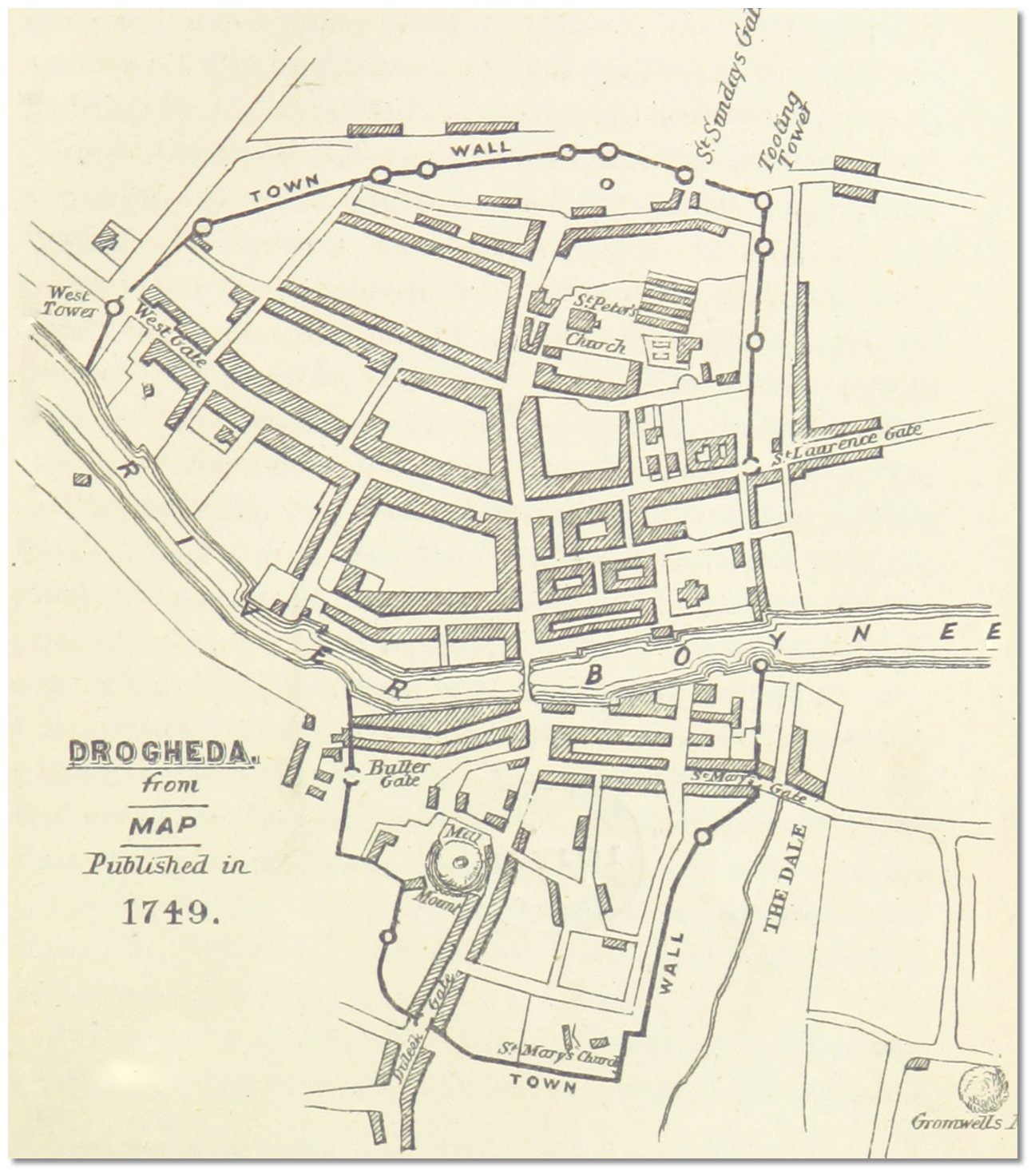 Map of Drogheda in 1749 showing its walls still intact
Map of Drogheda in 1749 showing its walls still intactImage: Public Domain
Drogheda was the first garrison he attacked during his 1649 invasion of Ireland. At that time Sir Arthur Aston had 3,100 English Royalist Regiment and Irish Confederate Army, roughly half English and half Irish, defending Drogheda. These were no match for Cromwell's 12,000 strong army and heavy siege guns. When Aston refused to surrender the town, Cromwell intended to make such an example of Drogheda that it would bring Irish Catholic resistance to an end. He was, by nature, a man who preferred assault over siege, and he blasted two holes in the wall on the 10th of September and ordered his men into the breach. The first assault was rebuffed and it was only after a second assault, led by Cromwell himself on foot, that the parliamentarians overran the town. In the heat of that action, Cromwell ordered "any that were in arms [be] put to the sword". The chaotic aftermath, this leads to 'The fall of Drogheda', has lived on in infamy.
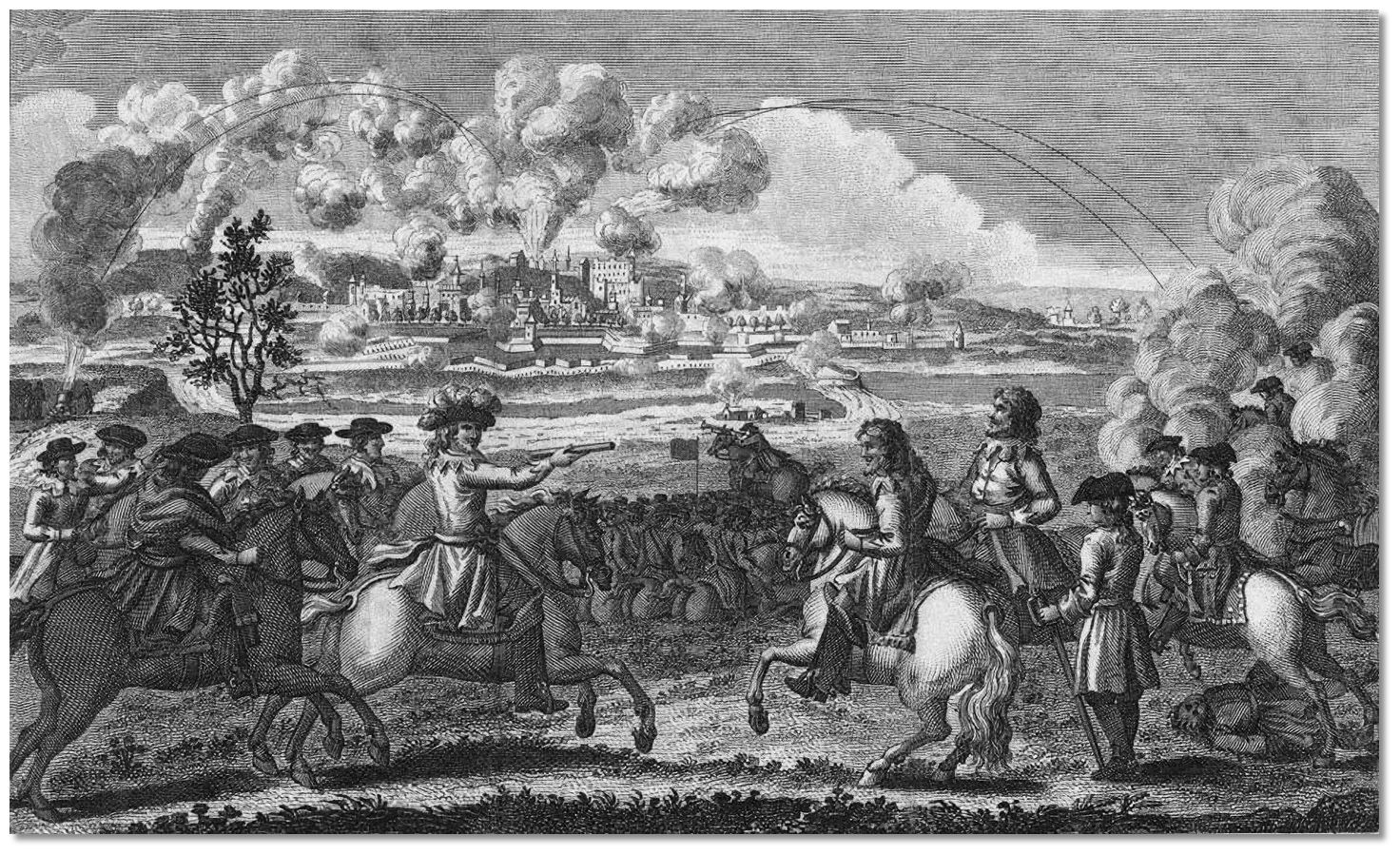 Cromwell bombarding Drogheda
Cromwell bombarding DroghedaImage: Public Domain
The subsequent massacre is estimated to have totalled 3,500 with an estimated 700 clergy and civilians amongst that number. The vast majority of the killing was carried out in cold blood the next day. Cromwell’s account, after the siege of Drogheda… "When they submitted, their officers were knocked on the head, and every tenth man of the soldiers killed and the rest shipped to Barbados". "Knocked on the head", as Cromwell put it, and it has since become a colloquialism, refers to the process of a single heavy club strike to the head, to effect mass executions whilst sparing ammunition.
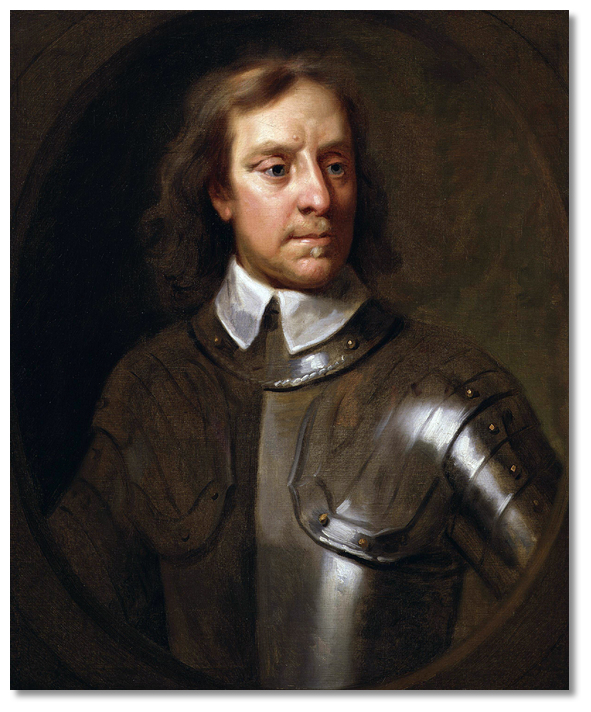 Oliver Cromwell
Oliver CromwellImage: Public Domain
By the standards of the day, Cromwell’s orders were not exceptionally barbarous. A fortified town that refused surrender and was then taken by assault was not entitled to any quarter. But the savagery meted out to civilian inhabitants as well as to the garrisons was at odds with Cromwell’s restraint in England. It was, literally, redolent of a deep-seated hostility that English and Scottish Protestants held toward the Irish Catholics. One which drove Cromwell to cruelly communicate to the population that he was the master and he would only accept total unconditional surrender. He justified this because it was consistent with the laws of war and that it would encourage more rapid surrenders elsewhere. This would bring Irish Catholic resistance to a speedy end and thus saving lives. But it would not be the case, and his absolute insisted upon unconditional surrender meant that this war would be a protracted campaign that would have an enormous cost in lives.
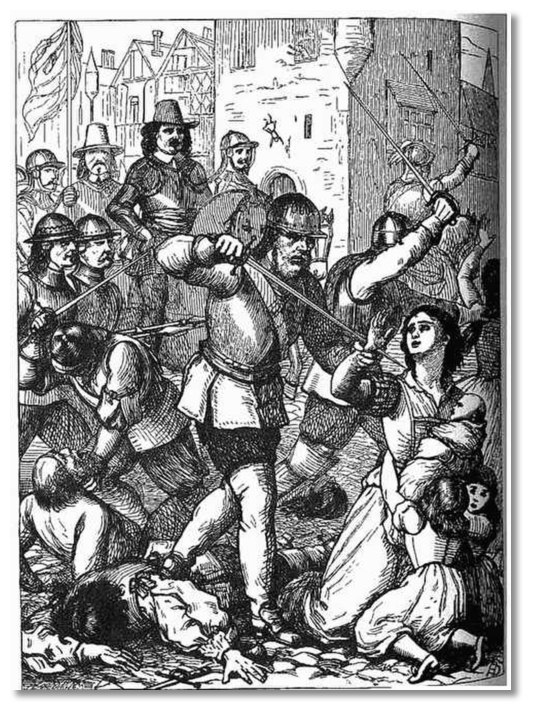 Depiction of Drogheda Massacre
Depiction of Drogheda MassacreImage: Public Domain
It would not be long until, another pivotal battle was to be fought nearby, one that is the most famous military engagement in Irish history. This was 'The Battle of the Boyne' that occurred 1 July 1690 on the banks of the River Boyne at Oldbridge roughly three miles to the west of the Drogheda. The battle was fought between two rival claimants of the English, Scottish and Irish thrones; the Catholic King James and the Protestant King William, who had deposed James in 1688. There, King William III's some 36,000 troops, who had landed in Carrickfergus, and an army of approximately 25,000 of mostly raw recruits led by King James II would decide who would carry the British crown and the continuance of the Protestant ascendancy in Ireland.
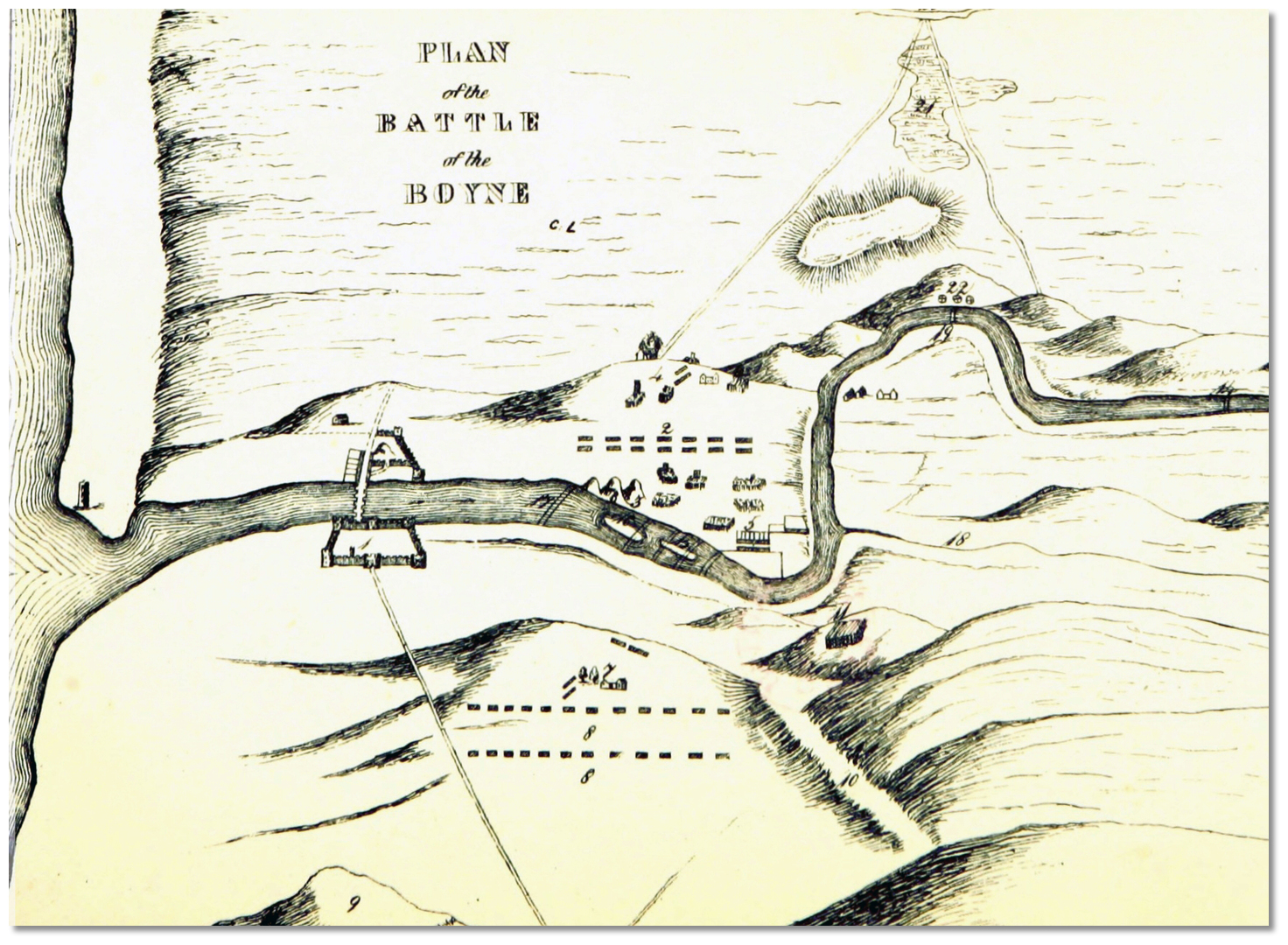 Battle of the Boyne Plan
Battle of the Boyne PlanImage: Public Domain
With William's forces vastly superior his victory was never in question. He was moving southward from Protestant-controlled Ulster to take Ireland and James moved to guard the capital by placing his army on the River Boyne, the best defensible obstacle between Ulster and Dublin. Drogheda was well garrisoned and so he moved to Oldbridge where the river was fordable. In the event, the casualty figures of the battle were quite low for a battle of such a scale. Of the 60,000 or so participants, about 2,000 died and the vast majority of the dead were Jacobites but William's army had far more wounded. At the time, most casualties of battles tended to be inflicted in the pursuit of an already-beaten enemy; this did not happen at the Boyne, as the counter-attacks of the skilled Jacobite cavalry screened the retreat of the rest of their army, Moreover, William was always disinclined to put James' life in danger, since he was the father of his wife, Mary.
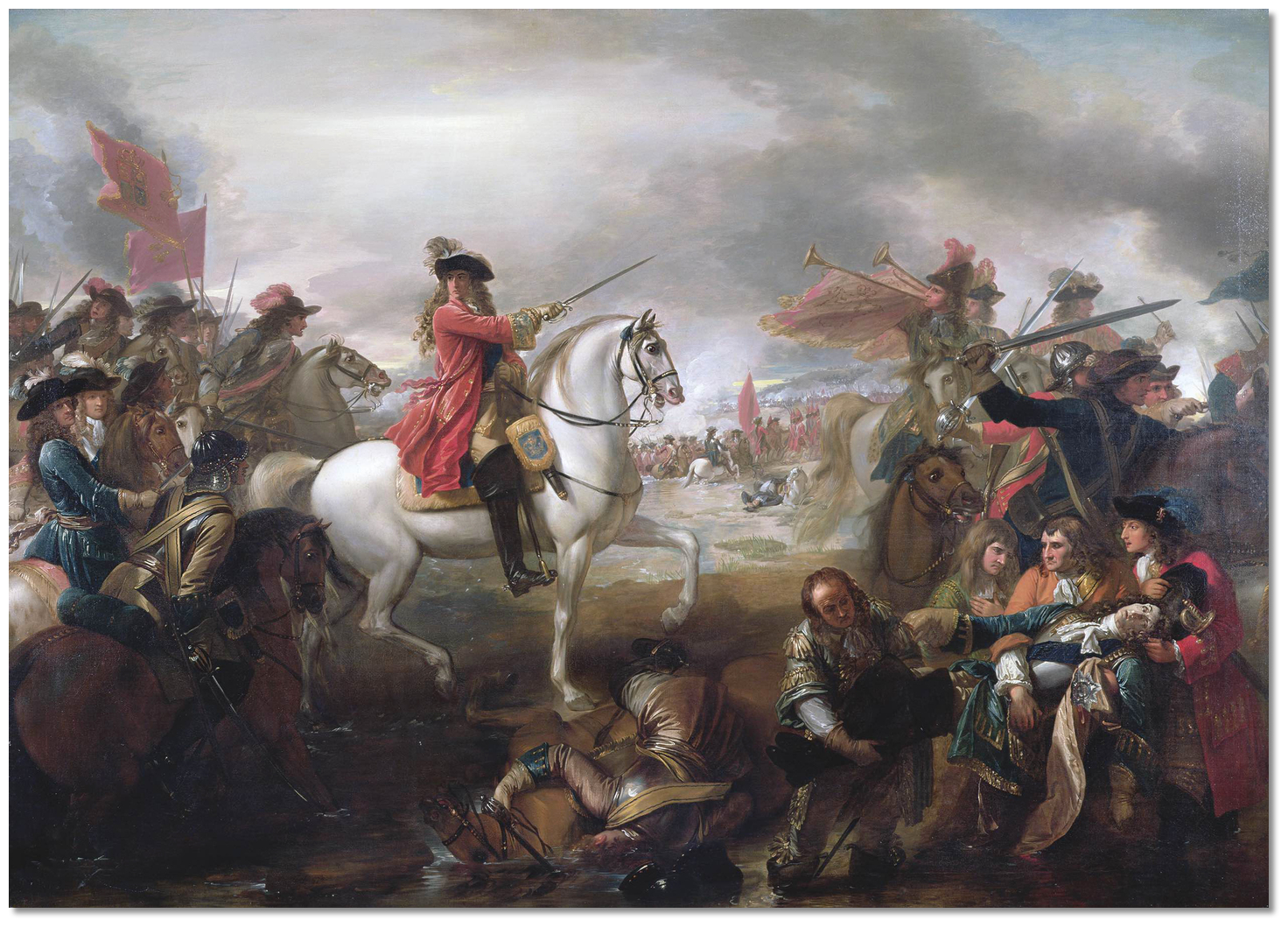 Battle of the Boyne
Battle of the BoyneImage: Public Domain
It nevertheless provided the turning point in James's unsuccessful attempt to regain the crown and ultimately helped ensure the continuation of Protestant ascendancy in Ireland. This became the source of bitter religious divisions for more than 300 years. The symbolic importance of this battle has made it one of the best-known battles in the history of the British Isles and a key part of the folklore of the Orange Order. Its commemoration today is principally by the Protestant Orange Institution, although today its commemoration is held on 12 July, on which the decisive Battle of Aughrim was fought a year later.
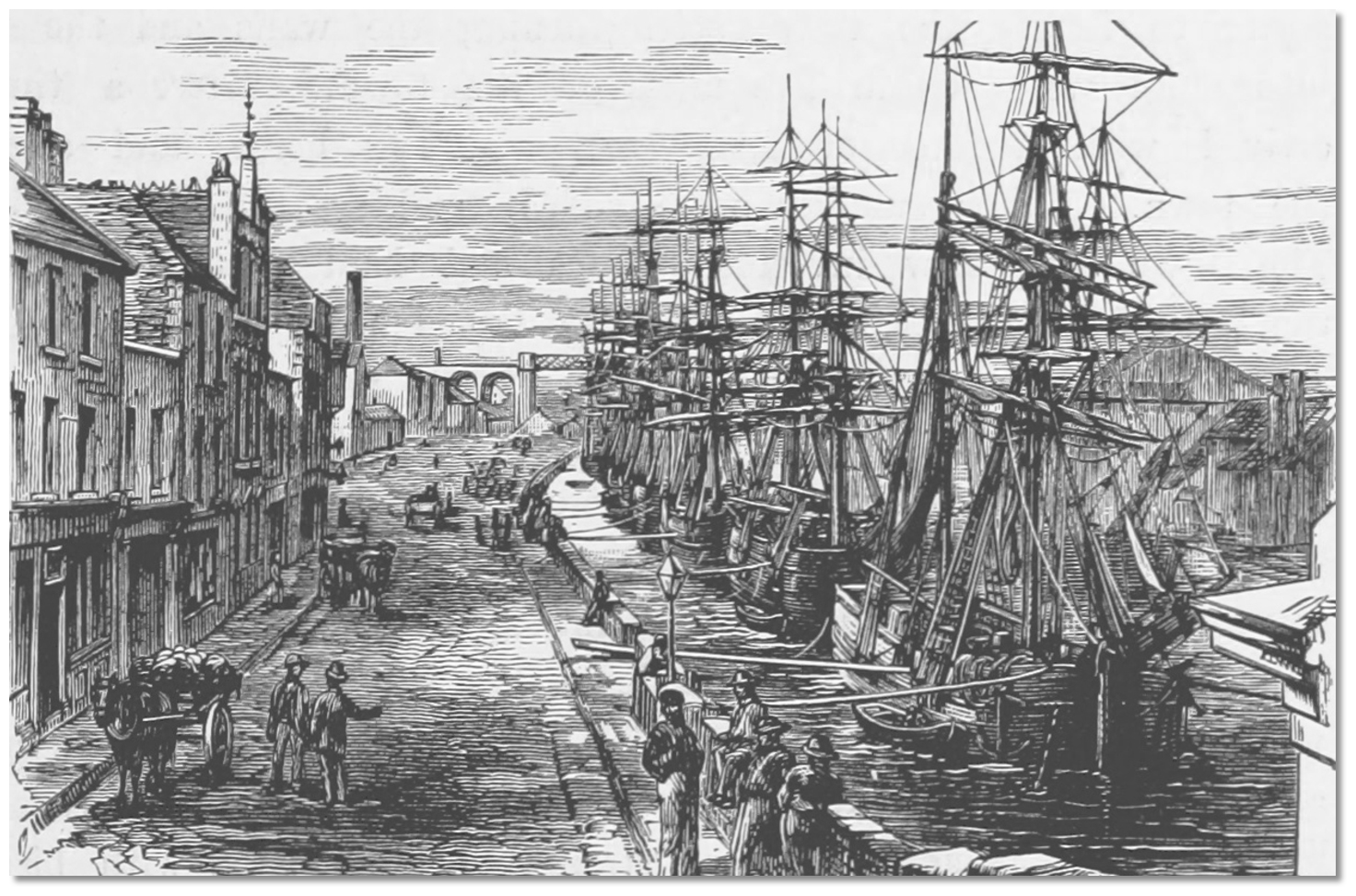 The Quays at Drogheda after the Boyne Viaduct was completed
The Quays at Drogheda after the Boyne Viaduct was completedImage: Public Domain
The signature piece for visitors to Drogheda by sea is the Boyne Viaduct. At the onset of the railway age, a critical railway link was needed between the two largest cities on the island, the administrative capital Dublin and the industrial centre Belfast. Nothing like it anywhere had ever been attempted and construction was full of problems and controversies. Stone arches were planned for the main parts of the bridge, but the span across the river would have to be made of iron. When it was completed in 1855 its final structure had 12 arches to the south and 3 arches to the north by, each measuring 18.5 metres across and a central span measures 81.5 metres. Standing 30.5 metres above high water with side spans measure 43.5 metres each, it was considered the engineering marvel of the age.
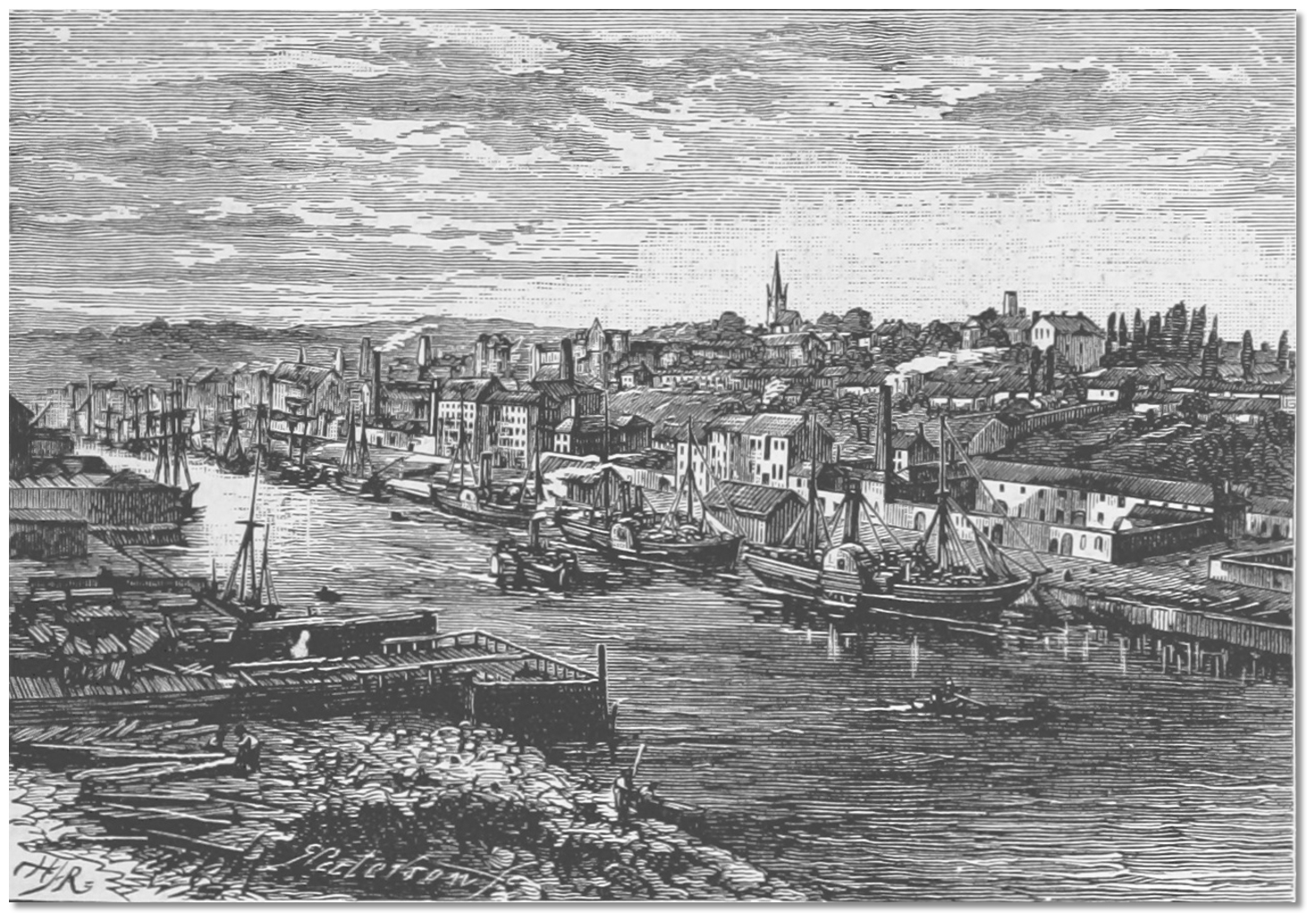 Drogheda in Victorian times
Drogheda in Victorian timesImage: Public Domain
In the 20th-century Drogheda played its role in the momentous events which shaped the modern nation including the 1916 Easter Rising, the War of Independence and the Civil War during the years 1919 – 1923. This central event was when the Millmount Fort was occupied by Anti-Treaty forces during July 1922. Winston Churchill who insisted that the Republican Forces be crushed and provided The Free State Forces of Michael Collins extensive British Army support. So it was that the same British Army 18 pounder artillery piece that had shelled the Republican H.Q. in the Four Courts in Dublin some days earlier bombarded Millmount fort for several hours before the Republican garrison retreated.
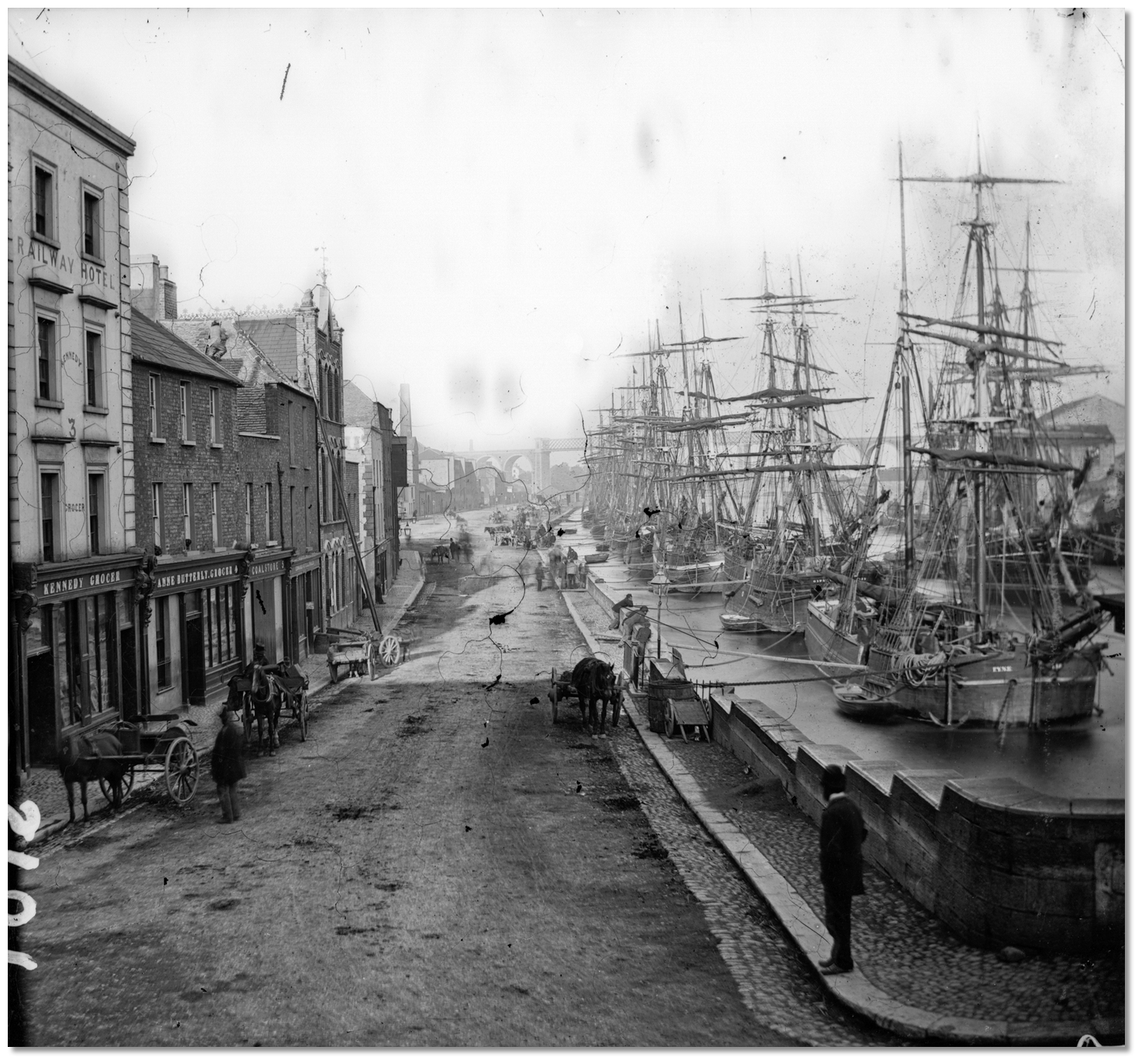 Drogheda in the late 1800s
Drogheda in the late 1800sImage: National Library of Ireland on The Commons
Today Drogheda is a busy port town and one of the main secondary locations for people to commute to work in Dublin. Nowadays it has a population of about 40,000, and is well known for its annual Samba festival. It is one of Ireland’s finest medieval towns and the gateway to the Boyne Valley and being of historical significance it is a rewarding location for the cruising boatman to visit. Visitors here enjoy a mix of old and new, it has abundant history and colour, with quiet lanes and busy shopping streets. The town still has its original street plan although little remains of Drogheda’s medieval defences but St Lawrence Gate has survived. Similar barbicans are known to have existed among the defences of other important medieval Irish towns, but this is the only surviving example. South of the river and high on the Norman motte the Millmount Martello tower was restored in 2000 and is now open to the public as a military museum. It contains interesting historical artefacts and tells Drogheda's history which may be further explored via many walks. The tower also provides splendid panoramic views over the town.
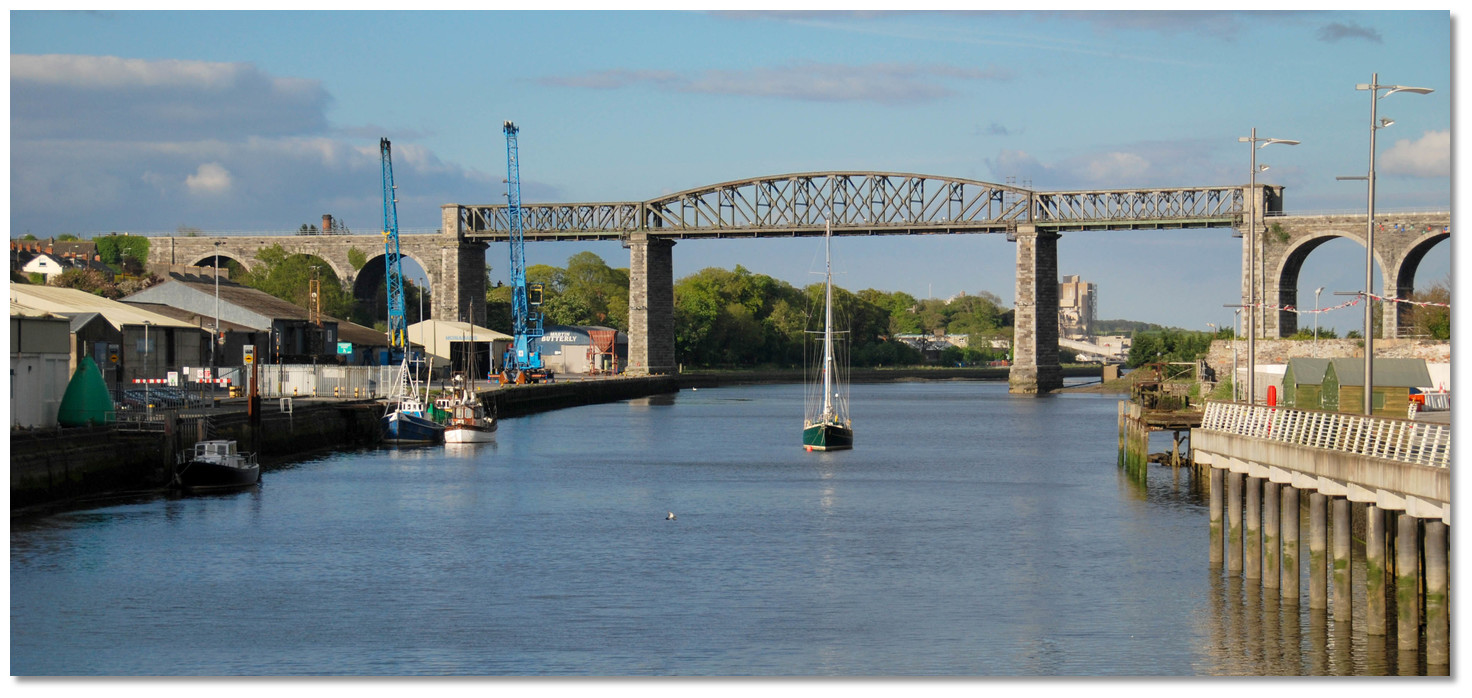 Boyne Viaduct today
Boyne Viaduct todayImage: Michael Harpur
From a boating perspective, Drogheda is a completely protected berth in the centre of a major provincial town. It enables a visiting boatman to weather any condition in a highly convenient location with excellent provisioning close to hand.
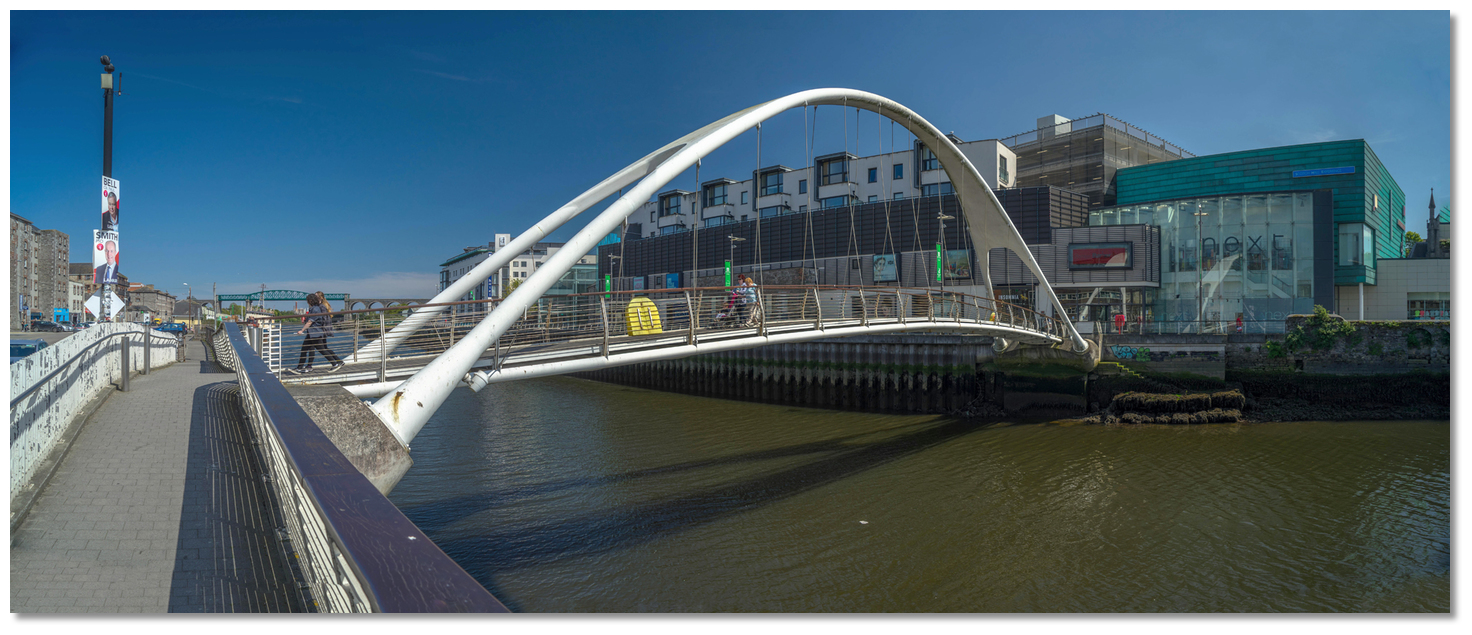 Drogheda's pretty De lacey Bridge
Drogheda's pretty De lacey BridgeImage: Michael Harpur
What facilities are available?
Water is available alongside at the Fiddle Case Pier but no power. Galley waste collection/disposal is available on request Saturday & Sunday 8am — 10am. Fiddle Case Pier is very close to the town centre, about 200 metres, with Scotch Hall shopping centre just across the river having the nearest public toilets.Drogheda has a population of 31,000 and is the third largest town in Ireland. Although there may be no services specifically targeted at yachting, it has all the amenities, pubs and restaurants that you would expect to service a population of that size. The town quay is in the middle of it all. Moreover, the newly opened riverside plaza shopping centre, that includes a supermarket, hotel, cinema, and a wide range of shops is a short stroll across the bridge from the quay. Water is available at the quay and diesel can be arranged by road tanker.
Drogheda also offers very good connections to Dublin city 56 km to the south, and is on the Belfast–Dublin main line of the Irish rail network. It is also 3 km from the M1, or E1 Euro Route 1, main Dublin to Belfast motorway. Dublin International Airport is 32 km to the south.
Any security concerns?
The pier construction is just outside the actual gates of Drogheda Port so it is not part of the restricted area of the port and open to the public.With thanks to:
Charles Floody, Drogheda Harbour Pilot for more than three decades.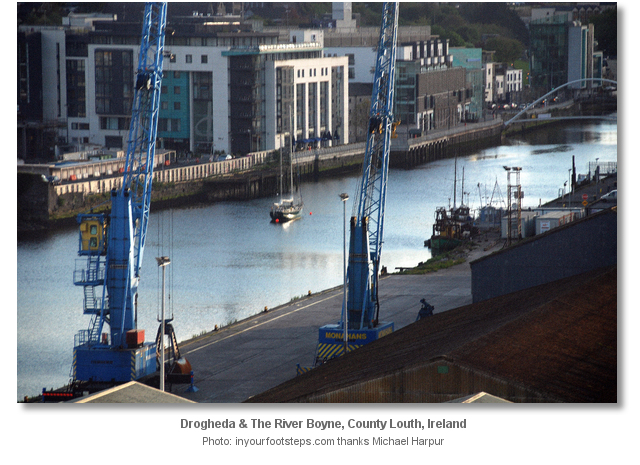
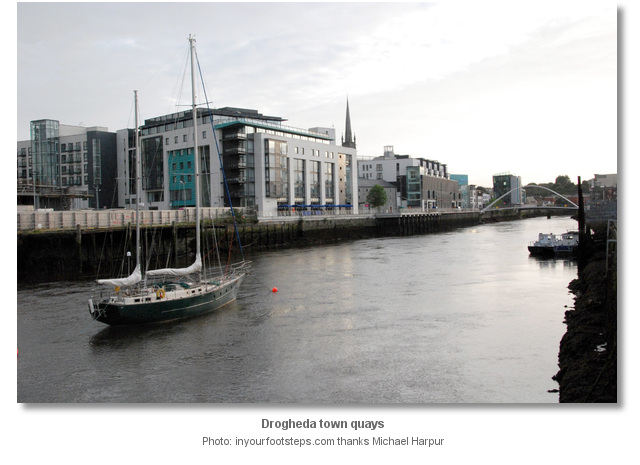
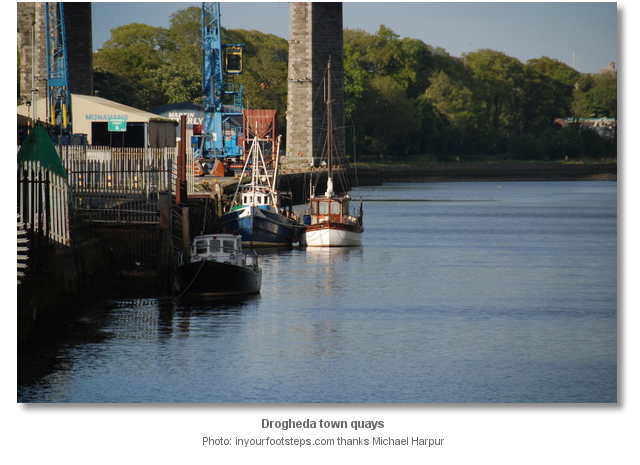
Drogheda and local area aerial views
A container ship exiting the channel
Aerial view of the town
About Drogheda & The River Boyne
Drogheda, in Irish 'Droichead Átha' meaning 'Ford bridge', is located in an area that is steeped in human history. The area abounds in archaeological monuments that date from the Neolithic period onwards. Most notable amongst them is the large Passage Tombs, or burial mound, of Newgrange that was a constructed around 3200 BC.
The earliest notices of the town of Drogheda go back to Roman times when it was a busy trading centre called 'Inver Colpa' or the 'Port of Colpa'. The Viking Danes built on this and established a trading centre and coastal stronghold here in 911 AD. The earliest structure in the town is the Norman motte-and-bailey castle, now the footing for the Martello styled Millmount Fort, that overlooks the town from a bluff on the south bank of the Boyne. This is thought to have been erected by the Norman Lord of Meath, Hugh de Lacy sometime before 1186.
 Millmount Monument
Millmount MonumentImage: Irish Typepad via cc by sa 2.0
Its most significant legacy is St Laurence's Gate. More properly described as a 'barbicans'. It stood in front of, and so provided extra protection for, a now-destroyed gateway in the Town Wall. A drawbridge Would have spanned the deep pit or ditch in the space between the barbican and the gate. The barbican was built in the 13th century, probably around 1250, when the original earthen rampart around Drogheda was replaced by a strong stone wall.
 St Laurence's Gate
St Laurence's GateImage: Michael Harpur
Drogheda took off under the Normans who found it as two separately administered towns in two different territories. Drogheda versus Midiam, County Meath as it was then known, i.e. the Lordship and Liberty of Meath, which was granted its charter by Walter de Lacy in 1194. Then Drogheda versus Uriel, as County Louth was then known, on the northern bank, that received its town charter in 1229. The division came on account of the 12th-century boundary between two Irish kingdoms, colonised by different Norman interests, just as the River Boyne continues to divide the town between the dioceses of Armagh and Meath. Although they immediately bordered one another, the two towns had separate corporations, taxes, tariffs and landing charges. Being an important trading town disputes soon arose when trading vessels landing their cargoes in the southern town, to avoid the duty levied in the northern town. At length, and after much blood had been shed in many disputes, Philip Bennett, a town monk, succeeded on the festival of Corpus Christi, 1412, in persuading the authorities of the two corporations to send to Henry IV for a new charter sanctioning their combination. In November of that year that a new Charter was granted, unifying the two towns as a County Corporate, styled as 'the County of the town of Droghede'.
 St Laurence's Gate more properly described as a barbican
St Laurence's Gate more properly described as a barbicanImage: Michael Harpur
Since Anglo/Norman times Drogheda was always considered by the English as an important place and as it was a walled town, that was less liable to attack from the natives, was largely settled by them. In the reign of Edward III, it was classed along with Dublin, Waterford and Kilkenny as one of the four staple towns of Ireland. In 1394, it was an important site when Richard II landed with his extensive army, the first King to come to Ireland since King John in 1210. Richard restored the power of his lordship over the whole of Ireland and gained the submission of 75 Irish chiefs at meetings in Drogheda as well as Carlow in 1395. It was here that the largest part submitted including the Irish princes of Leinster and Ulster. The town went on to be an important walled town in the English Pale, during the medieval period when it had the right to coin money and it frequently hosted meetings of the Irish Parliament. In a December 1494 an assembly of the parliament in Drogheda was held by the then recently-arrived Lord Deputy of Ireland, Sir Edward Poynings, as appointed by King Henry VII of England, that would seal the faith of the nation for 300 years.
 Warehouses along Drogheda's wharfs today
Warehouses along Drogheda's wharfs today Image: Michael Harpur
English authority in Ireland had at this time all but disappeared. Coming in the aftermath of the divisive Wars of the Roses, Poynings intended to curb the independence of Ireland’s Anglo-Norman chief governors and, once again, make Ireland obedient to the English monarchy. So, he enacted the 'Poynings' Law' or 'Poynings' Act' of 1495 that was formally known as the 'Statute of Drogheda'. This declared that the Parliament of Ireland was thereafter to be placed under the authority of the Parliament of England which limited its power and gave the English Parliament, and monarch, the power of veto over its legislation.
 The aftermath of the shelling of Millmount in 1922
The aftermath of the shelling of Millmount in 1922Image: Public Domain
It was noted that the Irish parliament "most willingly and joyously" consented to a Bill conferring on him the title 'King of Ireland'. But this was far from the case and the Irish Parliament resented its restrictive effect. Poynings' Law was a major rallying point for groups seeking self-government for Ireland, particularly the Confederate Catholics in the 1640s that would besiege Drogheda. This, the first Siege of Drogheda, took place from November 1641 to February 1642 during the Irish Rebellion of 1641. A Catholic force under Féilim Ó Néill laid siege to the town but failed to wrest the garrison from the Royalists. The Irish rebels made three attempts to break into and capture the town. All attempts failed and the town was ultimately relieved by English reinforcements from Dublin, under Colonel Moore, who was later created the Earl of Drogheda. A second, more famous siege of Drogheda took place less than a decade later during the war in 1649, when Oliver Cromwell's New Model Army took the town and massacred its Royalist and Irish Confederate garrison.
 Map of Drogheda in 1749 showing its walls still intact
Map of Drogheda in 1749 showing its walls still intactImage: Public Domain
Drogheda was the first garrison he attacked during his 1649 invasion of Ireland. At that time Sir Arthur Aston had 3,100 English Royalist Regiment and Irish Confederate Army, roughly half English and half Irish, defending Drogheda. These were no match for Cromwell's 12,000 strong army and heavy siege guns. When Aston refused to surrender the town, Cromwell intended to make such an example of Drogheda that it would bring Irish Catholic resistance to an end. He was, by nature, a man who preferred assault over siege, and he blasted two holes in the wall on the 10th of September and ordered his men into the breach. The first assault was rebuffed and it was only after a second assault, led by Cromwell himself on foot, that the parliamentarians overran the town. In the heat of that action, Cromwell ordered "any that were in arms [be] put to the sword". The chaotic aftermath, this leads to 'The fall of Drogheda', has lived on in infamy.
 Cromwell bombarding Drogheda
Cromwell bombarding DroghedaImage: Public Domain
The subsequent massacre is estimated to have totalled 3,500 with an estimated 700 clergy and civilians amongst that number. The vast majority of the killing was carried out in cold blood the next day. Cromwell’s account, after the siege of Drogheda… "When they submitted, their officers were knocked on the head, and every tenth man of the soldiers killed and the rest shipped to Barbados". "Knocked on the head", as Cromwell put it, and it has since become a colloquialism, refers to the process of a single heavy club strike to the head, to effect mass executions whilst sparing ammunition.
 Oliver Cromwell
Oliver CromwellImage: Public Domain
By the standards of the day, Cromwell’s orders were not exceptionally barbarous. A fortified town that refused surrender and was then taken by assault was not entitled to any quarter. But the savagery meted out to civilian inhabitants as well as to the garrisons was at odds with Cromwell’s restraint in England. It was, literally, redolent of a deep-seated hostility that English and Scottish Protestants held toward the Irish Catholics. One which drove Cromwell to cruelly communicate to the population that he was the master and he would only accept total unconditional surrender. He justified this because it was consistent with the laws of war and that it would encourage more rapid surrenders elsewhere. This would bring Irish Catholic resistance to a speedy end and thus saving lives. But it would not be the case, and his absolute insisted upon unconditional surrender meant that this war would be a protracted campaign that would have an enormous cost in lives.
 Depiction of Drogheda Massacre
Depiction of Drogheda MassacreImage: Public Domain
It would not be long until, another pivotal battle was to be fought nearby, one that is the most famous military engagement in Irish history. This was 'The Battle of the Boyne' that occurred 1 July 1690 on the banks of the River Boyne at Oldbridge roughly three miles to the west of the Drogheda. The battle was fought between two rival claimants of the English, Scottish and Irish thrones; the Catholic King James and the Protestant King William, who had deposed James in 1688. There, King William III's some 36,000 troops, who had landed in Carrickfergus, and an army of approximately 25,000 of mostly raw recruits led by King James II would decide who would carry the British crown and the continuance of the Protestant ascendancy in Ireland.
 Battle of the Boyne Plan
Battle of the Boyne PlanImage: Public Domain
With William's forces vastly superior his victory was never in question. He was moving southward from Protestant-controlled Ulster to take Ireland and James moved to guard the capital by placing his army on the River Boyne, the best defensible obstacle between Ulster and Dublin. Drogheda was well garrisoned and so he moved to Oldbridge where the river was fordable. In the event, the casualty figures of the battle were quite low for a battle of such a scale. Of the 60,000 or so participants, about 2,000 died and the vast majority of the dead were Jacobites but William's army had far more wounded. At the time, most casualties of battles tended to be inflicted in the pursuit of an already-beaten enemy; this did not happen at the Boyne, as the counter-attacks of the skilled Jacobite cavalry screened the retreat of the rest of their army, Moreover, William was always disinclined to put James' life in danger, since he was the father of his wife, Mary.
 Battle of the Boyne
Battle of the BoyneImage: Public Domain
It nevertheless provided the turning point in James's unsuccessful attempt to regain the crown and ultimately helped ensure the continuation of Protestant ascendancy in Ireland. This became the source of bitter religious divisions for more than 300 years. The symbolic importance of this battle has made it one of the best-known battles in the history of the British Isles and a key part of the folklore of the Orange Order. Its commemoration today is principally by the Protestant Orange Institution, although today its commemoration is held on 12 July, on which the decisive Battle of Aughrim was fought a year later.
 The Quays at Drogheda after the Boyne Viaduct was completed
The Quays at Drogheda after the Boyne Viaduct was completedImage: Public Domain
The signature piece for visitors to Drogheda by sea is the Boyne Viaduct. At the onset of the railway age, a critical railway link was needed between the two largest cities on the island, the administrative capital Dublin and the industrial centre Belfast. Nothing like it anywhere had ever been attempted and construction was full of problems and controversies. Stone arches were planned for the main parts of the bridge, but the span across the river would have to be made of iron. When it was completed in 1855 its final structure had 12 arches to the south and 3 arches to the north by, each measuring 18.5 metres across and a central span measures 81.5 metres. Standing 30.5 metres above high water with side spans measure 43.5 metres each, it was considered the engineering marvel of the age.
 Drogheda in Victorian times
Drogheda in Victorian timesImage: Public Domain
In the 20th-century Drogheda played its role in the momentous events which shaped the modern nation including the 1916 Easter Rising, the War of Independence and the Civil War during the years 1919 – 1923. This central event was when the Millmount Fort was occupied by Anti-Treaty forces during July 1922. Winston Churchill who insisted that the Republican Forces be crushed and provided The Free State Forces of Michael Collins extensive British Army support. So it was that the same British Army 18 pounder artillery piece that had shelled the Republican H.Q. in the Four Courts in Dublin some days earlier bombarded Millmount fort for several hours before the Republican garrison retreated.
 Drogheda in the late 1800s
Drogheda in the late 1800sImage: National Library of Ireland on The Commons
Today Drogheda is a busy port town and one of the main secondary locations for people to commute to work in Dublin. Nowadays it has a population of about 40,000, and is well known for its annual Samba festival. It is one of Ireland’s finest medieval towns and the gateway to the Boyne Valley and being of historical significance it is a rewarding location for the cruising boatman to visit. Visitors here enjoy a mix of old and new, it has abundant history and colour, with quiet lanes and busy shopping streets. The town still has its original street plan although little remains of Drogheda’s medieval defences but St Lawrence Gate has survived. Similar barbicans are known to have existed among the defences of other important medieval Irish towns, but this is the only surviving example. South of the river and high on the Norman motte the Millmount Martello tower was restored in 2000 and is now open to the public as a military museum. It contains interesting historical artefacts and tells Drogheda's history which may be further explored via many walks. The tower also provides splendid panoramic views over the town.
 Boyne Viaduct today
Boyne Viaduct todayImage: Michael Harpur
From a boating perspective, Drogheda is a completely protected berth in the centre of a major provincial town. It enables a visiting boatman to weather any condition in a highly convenient location with excellent provisioning close to hand.
 Drogheda's pretty De lacey Bridge
Drogheda's pretty De lacey BridgeImage: Michael Harpur
Other options in this area
Skerries Bay and Harbour - 7.1 miles SE
Loughshinny - 8.6 miles SE
Rush Harbour - 9.2 miles SE
Rogerstown Inlet - 9.1 miles SSE
Dundalk - 11 miles N
Giles Quay - 10.2 miles NNE
Carlingford Harbour - 12.7 miles NNE
Carlingford Marina - 12.9 miles NNE
Navigational pictures
These additional images feature in the 'How to get in' section of our detailed view for Drogheda & The River Boyne.
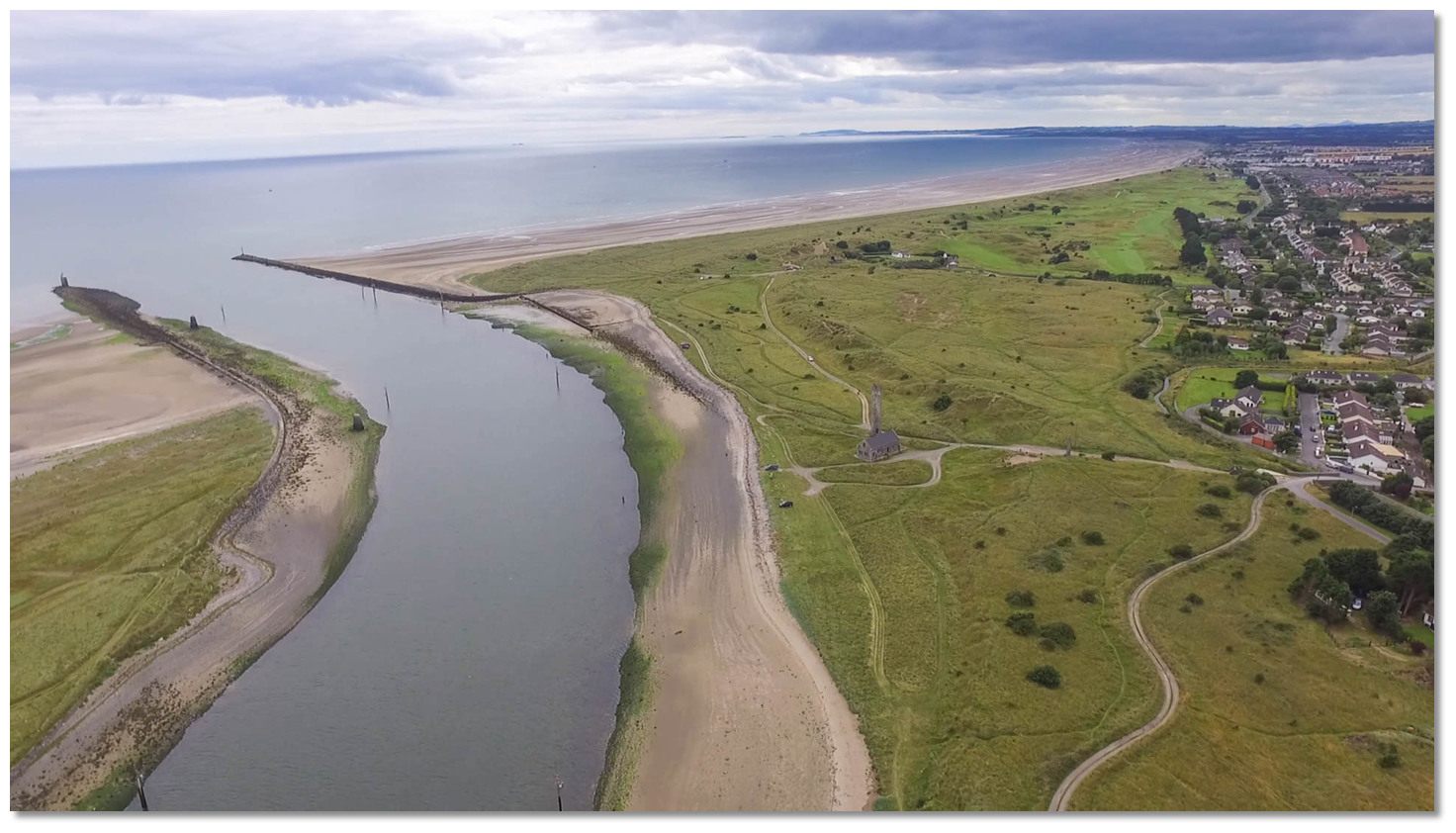


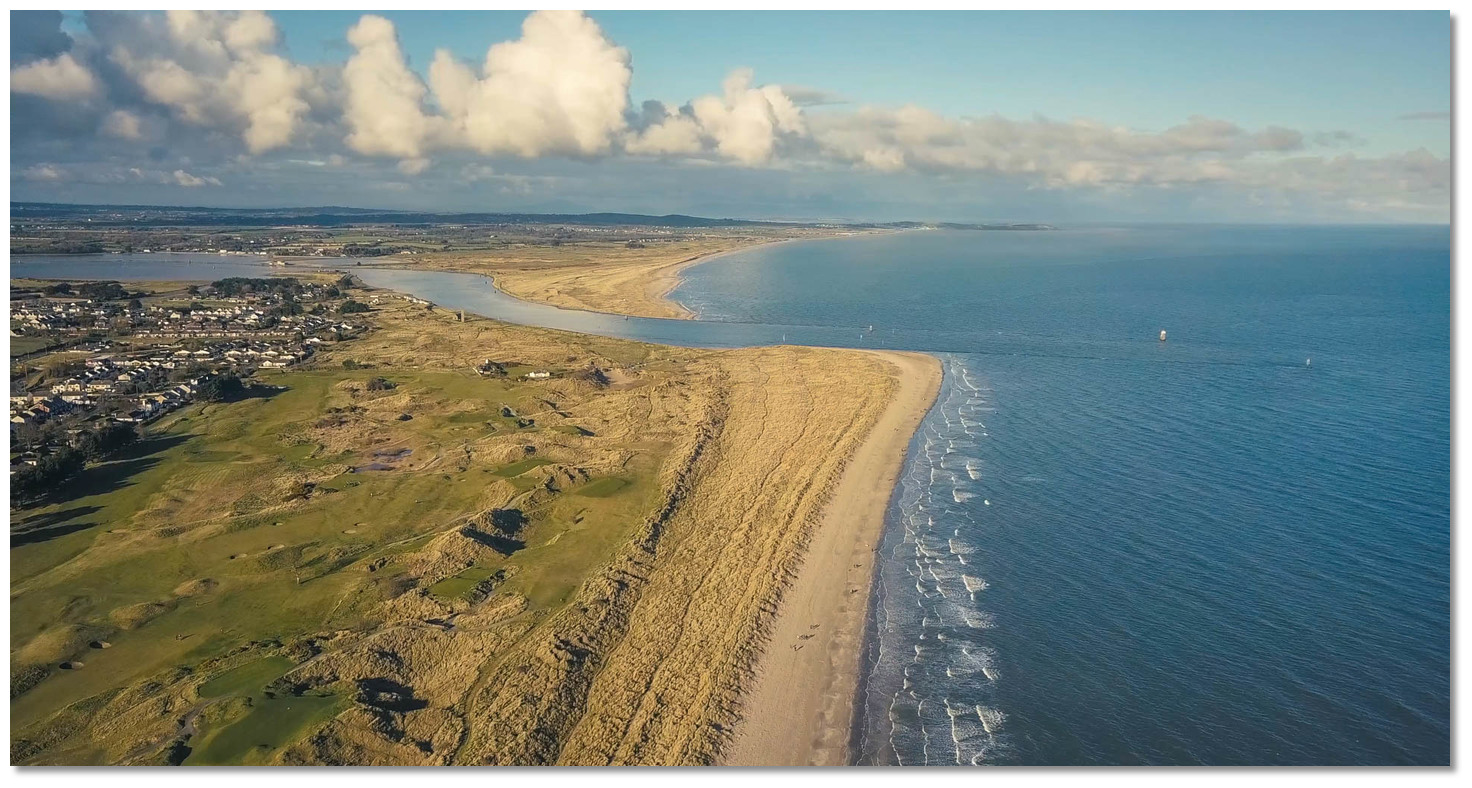


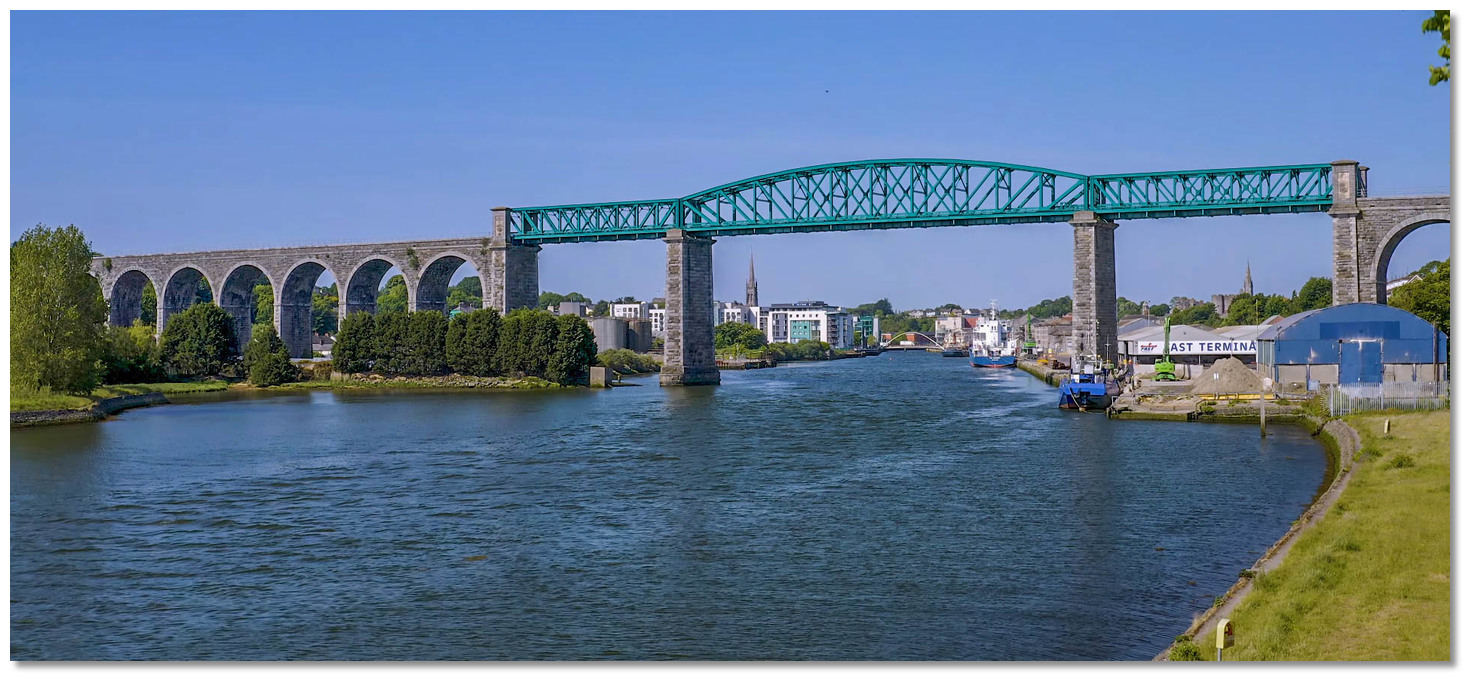
_past_premier_periclase_has_a_least_depth_of_1.3_metres.jpg)
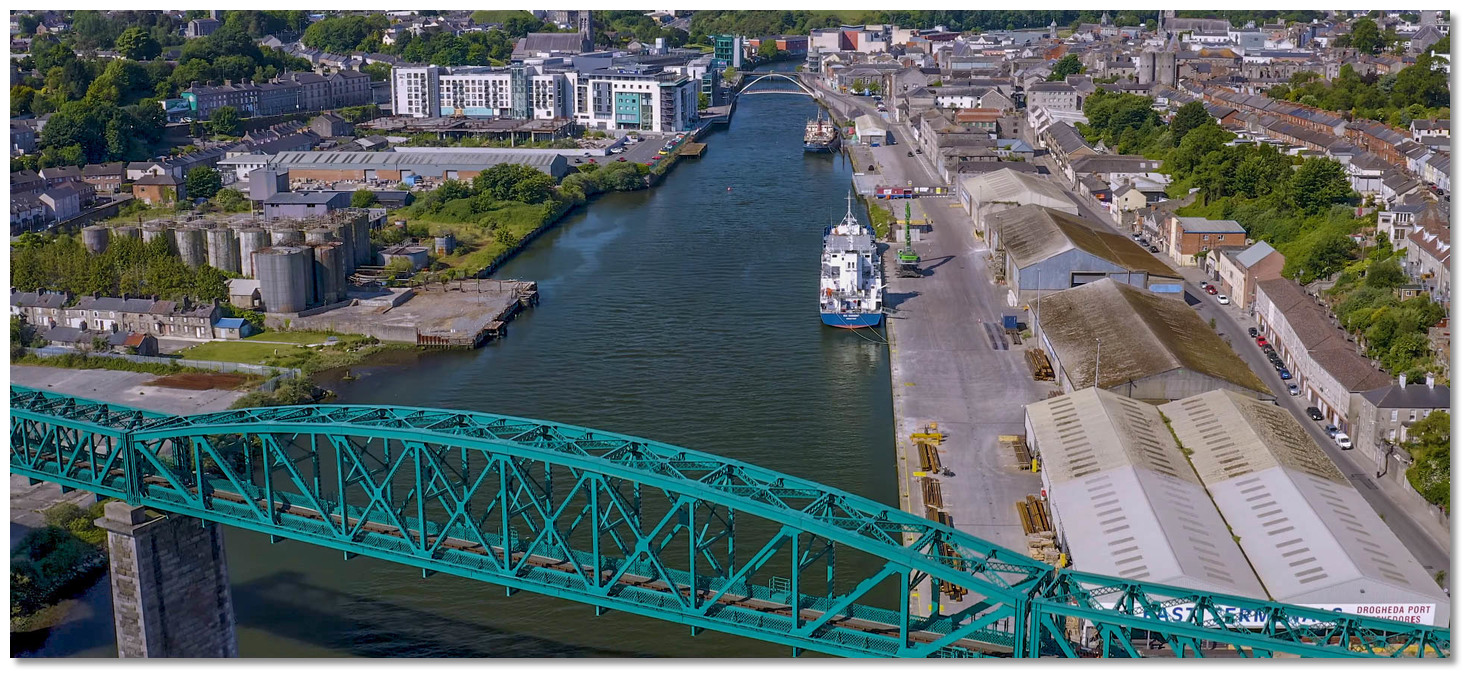






















| Detail view | Off |
| Picture view | On |
Drogheda and local area aerial views
A container ship exiting the channel
Aerial view of the town
Add your review or comment:
Frrd Fred wrote this review on Sep 25th 2022:
Fiddle Case Pier has 1m at. CD
Average Rating: UnratedMichael Harpur wrote this review on Sep 26th 2022:
Hi Fred,
Thank you for the update. The main text has been corrected.
Please log in to leave a review of this haven.
Please note eOceanic makes no guarantee of the validity of this information, we have not visited this haven and do not have first-hand experience to qualify the data. Although the contributors are vetted by peer review as practised authorities, they are in no way, whatsoever, responsible for the accuracy of their contributions. It is essential that you thoroughly check the accuracy and suitability for your vessel of any waypoints offered in any context plus the precision of your GPS. Any data provided on this page is entirely used at your own risk and you must read our legal page if you view data on this site. Free to use sea charts courtesy of Navionics.








